Freely Available British and Irish Public Legal Information
[Home] [Databases] [World Law] [Multidatabase Search] [Help] [Feedback]
England and Wales High Court (Patents Court) Decisions
You are here: BAILII >> Databases >> England and Wales High Court (Patents Court) Decisions >> Evalve Inc & Ors Edwards Lifesciences Ltd [2020] EWHC 514 (Pat) (12 March 2020)
URL: http://www.bailii.org/ew/cases/EWHC/Patents/2020/514.html
Cite as: [2020] EWHC 514 (Pat), [2020] RPC 12
[New search] [Printable PDF version] [Help]
BUSINESS AND PROPERTY COURTS OF ENGLAND AND WALES
INTELLECTUAL PROPERTY LIST (ChD)
PATENTS COURT
The Rolls Building 7 Rolls Buildings Fetter Lane London EC4A 1NL |
||
B e f o r e :
____________________
| (1) EVALVE INC. (2) ABBOTT CARDIOVASCULAR SYSTEMS INC. (3) ABBOTT MEDICAL U.K. LIMITED |
Claimants |
|
| - and - |
||
| EDWARDS LIFESCIENCES LIMITED |
Defendant |
____________________
Iain Purvis QC, Piers Acland QC, and Kathryn Pickard (instructed by Powell Gilbert) for the Defendant
Hearing dates: 9th - 13th, 17th and 18th December 2019
____________________
Crown Copyright ©
- This action is about two patents, EP (UK) 1 408 850 entitled "Devices for capturing and fixing leaflets in valve repair" and EP (UK) 1 624 810 entitled "Fixation devices and systems for engaging tissue". Each patent is owned by the first claimant (Evalve), exclusively licensed to the second claimant (Abbott Cardiovascular Systems Inc) and the third claimant (Abbott Medical UK Ltd) is the UK exclusive sub-licensee. All three companies are part of the Abbott Laboratories group and can be referred to compendiously as Abbott. Both Abbott and the defendant (Edwards Lifesciences Ltd) are major international life sciences technology businesses.
- The 850 patent was filed on 27th June 2002 claiming priority from a US filing dated 27th June 2001. It was granted on 23rd September 2009. The 810 patent was filed on 18th May 2004 claiming priority from 3 simultaneous US filings made on 19th May 2003. It was granted on 5th July 2017. The 810 is still in opposition in the EPO. On 4th November 2019 the Opposition Division upheld the patent in an amended form.
- The patents relate to medical devices used to treat mitral valve regurgitation by a transcatheter technique. The patents protect a successful Abbott product called MitraClip which has been on the market since 2008. In the human heart the mitral valve is the valve from the left atrium leading into the left ventricle. Mitral valve regurgitation is a disorder characterised by the inability of the valve to close fully and stop blood flowing back from the left ventricle into the left atrium instead of flowing where it ought to go onto the aorta. It is a common disorder prevalent in 1.7% of the population, with the prevalence rising sharply with age. One estimate for the prevalence in the over-75s is up to 10%. The MitraClip has been a truly transformative advance in the treatment of this disorder. Before the MitraClip there was no effective transcatheter treatment available. The only effective treatments involved open heart surgery. One surgical approach was annuloplasty and another more recent one was called the Alfieri stitch. They will be described in more detail below. Those patients with progressive mitral valve regurgitation have a poor prognosis and without treatment many will die within a year of diagnosis. However a significant number of the elderly patients with mitral valve regurgitation are not strong enough to be able to have open heart surgery. That is why the ability to treat the disorder by a transcatheter technique, which does not involve open heart surgery, is so significant.
- Starting from before the earliest priority date of the patents, Edwards sought to develop a transcatheter treatment for the disorder. The product was called MOBIUS and was based on trying to translate the Alfieri stitch approach into a transcatheter technique. It worked in a different way from the MitraClip. The MOBIUS was taken into clinical trials but did not lead to an approved product and the MOBIUS project was stopped. Now Edwards have produced a new product called PASCAL. PASCAL achieved CE mark approval in 2019. Abbott contends PASCAL infringes both patents. Edwards denies infringement and contends both patents are invalid.
- The prior art publications relied on are International Patent Application PCT/US00/09290 published as WO 00/60995 on 19th October 2000 (Deem) and US patent application US2002/0013571 A1 published on 31st January 2002 (Goldfarb). Both Deem and Goldfarb are Evalve patent applications which were part of the development work which led to Mitraclip. Goldfarb is a publication of the US application in the same family which produced the 850 patent in Europe. Deem is relied on as full prior art to the 850 patent and Goldfarb as full prior art to the 810 patent. In fact the disclosures within these documents on which Edwards builds its case are the same figures which appear in both (and in 850) although there is a difference in the text between Deem and Goldfarb which needs to be addressed.
- Until close to trial Edwards also relied on a published application called Kuehn (WO 00/03759, published 27th January 2000). This came from a different group (St Jude Medical Inc, another well known cardiac device company). Much of the expert evidence was prepared starting from Kuehn but by the trial Edwards focussed their case on Deem and Goldfarb.
- In addition, Edwards advances added matter arguments against the claims of the 810 patent.
- Abbott relies on claims 1, 8, 11 and 17 of the 850 patent. Abbott argues that claim 1 is essentially the same as claim 11, and claim 8 similarly pairs with claim 17, although the added matter issues may differ.
- Abbott relies on claims 1, 2, 4, 14, 16, 18, and 19 of the 810 patent. By closing only one set of claim amendments were in issue. The set is called Modified Conditional Amendment F. The Comptroller made observations about these amendments and those need to be addressed too if the amendments are relevant. Abbott asks the court to rule that the amendments would be allowable (even if they are not necessary to validate the existing claims) since that would avoid further proceedings if those claims are what emerged from the EPO.
- Both Abbott and Edwards called expert evidence from a bio-engineer and a consultant interventional cardiologist. The experts' reports supported the case advanced by the party calling them.
- Abbott's bio-engineer expert was Dr Bruce Murphy. Dr Murphy is an Associate Professor in Biomedical Engineering at Trinity College, Dublin. Dr Murphy's current research includes the development of minimally invasive medical devices to treat diseases in relation to transcatheter heart valve repair and replacement. He led the development of a new mitral valve replacement/repair device at Trinity College from 2009.
- Abbott's cardiologist expert was Dr Christopher Baker. Since 2002, Dr Baker has held the position of a Consultant Cardiologist with a special interest in interventional cardiology at Imperial College Healthcare NHS Trust. He has used the MitraClip device, and was responsible for the development of the MitraClip program at his hospital.
- Abbott also called evidence from Dr Stephen Kuehn, the inventor of the Kuehn patent application. From 1997 he led a project at St Jude to translate the Alfieri stitch procedure into a less invasive transcatheter system. The project was abandoned in 1999. Abbott relies on this as part of its answer to Edwards' obviousness case. He was not cross-examined.
- Edwards' bio-engineer expert was Mr Jonathan Rourke. Mr Rourke is an engineer who began working in the field of cardiovascular medical devices in 1991. In 2012 he co-founded MitraSpan, Inc., which is a research incubator of mitral and cardiac structural techniques.
- Edwards' cardiologist expert was Dr Nigel Buller. Dr Buller was the Head of Interventional Cardiology at the Queen Elizabeth Hospital, Birmingham and the Lead Clinician for its Cardiac Catheterization Laboratories until January 2008. Since then he has not carried out clinical work but has kept closely involved in developments in treatments. Dr Buller first appeared as an expert witness in a patent case in the Palmaz stent case in 1999 (Boston Scientific v Palmaz). He has given evidence as an expert a number of times in patent cases in the UK and USA. Most of these appearances have been either for Cordis/Wyeth or for Edwards.
- Edwards also made Mr Philip Corso available for cross-examination. Mr Corso is Vice President, Alliance Management of Edwards. He proved the Product and Process Description. He was not cross-examined.
- Abbott contended that the evidence of both Dr Buller and Mr Rourke suffered from various problems. Edwards had concerns about Dr Baker's evidence and raised concerns about the way Dr Murphy was instructed. I was not convinced any of these matters were sufficient to justify taking a wholesale approach to their evidence, e.g. by preferring one witness to another other than by reference to the cogency of the reasons they gave. All four experts were qualified to give their evidence and did so trying to help the court understand the issues.
- The skilled person is a team consisting of an interventional cardiologist and a biomedical engineer. They would be interested in designing and developing products to treat cardiovascular conditions, in particular mitral regurgitation. The interventional cardiologist would take the lead in identifying clinical approaches and requirements and the engineer would take the lead in working out how to achieve those needs.
- The common general knowledge can be treated as the same for both priority dates (June 2001 for 850 and May 2003 for 810). The only significant change was the first in man demonstration of a different cardiovascular transcatheter technique called TAVI (see below). The only other possible difference relates to a product called the valvulotome which I will mention below.
- The cardiovascular system and its anatomy would be part of the common general knowledge.
- The mitral valve has two leaflets and is referred to as "bicuspid". The two leaflets are connected to a flexible fibrous ring known as the annulus. The anterior leaflet is towards the front of the human body while the posterior leaflet is towards the back. The leaflets are also attached to the ventricular wall by a complex network of small tendinous strings called the chordae tendinae, or just the chordae. The atrial sides of the leaflets have two zones known as the smooth and rough zones. The illustration below is a diagrammatic representation of the whole mitral valve laid out flat. The rough zones are shaded and the chordae can be seen as the tree-like structure below the valve:
- Ventricular systole is the stage during the cycle of heart beats when the large ventricular heart muscles contract and pump the blood out of the ventricle and into the aorta and so around the whole body (except the lungs). During ventricular systole the mitral valve is supposed to close, in order that the blood flows in the right direction. When the mitral valve closes the rough zones come together and form a seal. In the medical jargon they are said to coapt and the sealing process is called coaptation. An illustration of the seal is:
- This case is concerned with mitral regurgitation, which is the inability of the mitral valve to close fully to stop blood from flowing backwards from the left ventricle into the left atrium.
- Another, different kind of valve disease is mitral stenosis. If mitral regurgitation is a problem with the closed valve not closing enough, then mitral stenosis is a problem with the open valve not opening enough. More precisely it is a reduction in the cross-section of the mitral valve which restricts blood flow through it.
- There are different types of mitral regurgitation. Degenerative or primary mitral regurgitation arises when the components of the valve are damaged or deformed. Two subtypes are called "flail" and "prolapse", referring to the position of the leaflet. Secondary or functional mitral regurgitation arises from changes to the left ventricle itself which pull the leaflets out of shape or alignment. In either case the leaflets do not coapt properly. The different types are illustrated in this diagram:
- Prolapse and flail in degenerative mitral regurgitation are depicted in the middle two diagrams. Functional mitral regurgitation is on the right. One can visualise how annuloplasty could perhaps treat mitral regurgitation by trying to squeeze the annulus and reducing its diameter, so as to bring the leaflets back together again. This might work particularly for functional mitral regurgitation.
- Another treatment for mitral regurgitation was the Alfieri stitch, also called edge to edge repair or the bow-tie repair. The two leaflets are sutured together to form a double orifice. It is depicted in the image below:
- The major drawback is that this technique requires open heart surgery, which is not suitable for many elderly patients.
- There was a point of detail about what was thought about normal coaptation and the location of the sutures relative to the rough zones of the leaflets. This is best addressed in context below.
- Interventional cardiology is the discipline whereby percutaneous catheter-based techniques are used to treat cardiac disease. Interventional techniques offer an alternative to surgery with many advantages, all well known at the priority date(s). Unlike interventional cardiology, cardiac surgery involves a large incision, the division of bones, a general anaesthetic and stopping the heart or a cardio-pulmonary bypass. With interventional cardiology patients typically lose less blood, recover more quickly, and spend fewer days in hospital. They suffer less discomfort and have a better reported quality of life in the recovery period. As such, interventional techniques are significantly lower risk than surgery and can be used to treat a wider population of patients e.g. the frail and elderly and/or those with significant comorbidities.
- In this field the terms distal and proximal usually refer to the perspective of the interventional cardiologist with a catheter. Distal is further away along the catheter from the interventional cardiologist, and proximal is in closer proximity to the interventional cardiologist.
- At the priority date(s) there were a number of interventional techniques in clinical use. Balloon angioplasty is a technique to improve blood flow through stenosed arteries by using a balloon to enlarge the lumen of the blood vessel, possibly followed by the implanting of a stent to provide a scaffold that holds the artery open and allows the blood to flow. Pacemakers could be implanted percutaneously. Septal closure devices were used to treat structural heart defects, commonly referred to as holes in the heart. These devices typically comprised two discs made of fabric mounted on hinged legs which, in their compressed state, would be aligned on either side of the septal defect and then released to occlude it. A number of such devices were known by the priority date(s), including the CardioSEAL and the Amplatzer septal occlusion device.
- Another known interventional cardiovascular technique was percutaneous valvuloplasty. Edwards, supported by Dr Buller, place emphasis on this. It was a treatment for valve stenosis and involved the introduction of a balloon (or two small balloons) into the heart and placement of the balloon(s) on either side of the mitral valve using a guidewire. Once in position, the balloon(s) are inflated so as to open the valve. Great care had to be taken to ensure that the guidewire was not entangled with the chordae. The 'Inoue Balloon' was one of the widely used devices for this. Once positioned across the valve orifice, the balloon inflates first distally, and then proximally, to allow it to be accurately and stably positioned before the waist of the balloon is then inflated, which causes the valve to open. In my judgment the interventional cardiologist member of the skilled team would know of this technique. They may or may not have employed it themselves. However I was not convinced percutaneous valvuloplasty would play any significant part in the thinking of the interventional cardiologist in the skilled team considering treatments for mitral regurgitation. Edwards' emphasis on this is tainted with hindsight, looking back from the invention and seeing similarities with the Inoue balloon. The notional skilled team did not think like that.
- Another technique for treating mitral stenosis was to use a device called the valvulotome. Dr Buller was aware of it but Dr Baker was not. I find the valvulotome was not common general knowledge.
- By the relevant dates two transcatheter heart valve replacement (THV) techniques were part of the common general knowledge. They were pulmonary valve replacement ("TPVR") and transcatheter aortic valve implantation ('TAVI') which was first carried out in man in April 2002 (i.e. between the priority dates). Dr Buller's evidence was that the advent of THV represented a significant milestone in interventional cardiology. I accept that.
- Dr Buller's view, which I accept, is that there was at the time intense interest in adapting surgical valve repair/replacement techniques for use in catheter-based procedures and that this was particularly true for patients with severe mitral regurgitation, many of whom were ineligible for open heart surgery. I find that the relevant team, as a matter of common general knowledge, was closely interested in the idea of trying to adapt surgical valve repair using transcatheter techniques, in order to treat mitral regurgitation. I do not think Dr Baker disagreed with this. He also said that at the time interventional cardiologists were mainly focused on coronary artery disease and stenting. I do not doubt that in general terms. It is not inconsistent with the finding.
- The skilled team would know that the mitral valve could be approached from two directions, known as antegrade and retrograde. With the antegrade approach the catheter is advanced through a vein, usually via the femoral vein, from where it travels up through the vena cava and into the right atrium. However the mitral valve is in the left atrium. In order to get into the left atrium a puncture has to be made in the wall between these two chambers of the heart. The wall is called the septum and the puncture is called a trans-septal puncture. The device is then above the mitral valve on the atrial side. The trans-septal puncture approach is a technique used to deliver some septal occluder devices.
- The retrograde approach involves advancing the catheter through the arterial system. It travels through the aortic valve and directly into the left ventricle, below the mitral valve.
- Veins are more flexible than arteries and they are easier to navigate because they are typically less diseased. The lower pressures in the venous system also reduce the risk of haemorrhage. Furthermore approaching the mitral valve from the atrial side reduces the risk of entanglement with the chordae and the rest of the sub-valvular apparatus. For these reasons it was common ground that the antegrade approach would be preferred by a skilled team contemplating using an interventional technique to treat mitral regurgitation. On the other hand I do not believe that preference was strong enough to mean that the skilled team would simply discount or ignore any proposal to use a retrograde approach.
- Turning to the engineer member of the skilled team, they were very familiar with catheter based delivery systems used in interventional cardiology, including the need for accurate delivery of a device to moving heart tissue, and how to fix it in place. This also included knowledge of the long term challenges such as implant durability, tissue integration and clotting performance.
- Various manufacturing methods and materials were also known, including the use of a nickel-titanium alloy called nitinol which can be "shape set" into a desired configuration by the application of heat. Nitinol was one of the materials (together with stainless steel and cobalt-chromium alloys) that was known to have been successfully used in the field of interventional cardiology.
- A point on surgical techniques relates to sutures (stitches) and "clips". Edwards also contended that "clips" had known advantages over sutures. One needs to be careful with this. True sutures use a thread. There are also many suture-like approaches which use a small metal rivet-like device or stud. They are quite often called clips but they are nothing like the "MitraClip" and nothing like the detachable grasping and holding implant devices in the prior art considered in this case. I will use the term rivets to refer to the small metal products, some of which are called surgical clips. It is right that these rivets did have perceived advantages over true sutures made with thread, but it is a different point from any view comparing sutures to implanted devices.
- There was a debate about what the skilled team would regard as essential features of a product (or user requirements). This is best addressed in context relating to the 810 patent.
- Patent law has identified the concept of a "long felt want" or "long felt need". Based on the technical evidence about the common general knowledge, I am sure that there was a need for an effective interventional cardiology based technique to treat mitral regurgitation, and it was felt by real skilled teams including interventional cardiologists. In other words real teams had identified the problem and knew that they wanted to solve it. How long was it? The Alfieri technique had been in the literature since 1995. The best way to characterise the point in my judgment is that real teams were looking to solve this problem for at least a few years before the priority date. In other words, based on the evidence about common general knowledge in this case, I find there was a reasonably long felt want at the first priority date (June 2001) and a longer one at the second priority date (May 2003).
- Nevertheless it bears pointing out that a long felt want may have little relevance to an obviousness case based on prior art unknown to the real teams or on prior art emerging close to the priority date.
- Edwards detected that Abbott was seeking to rely on an unpleaded commercial success argument. It is convenient to address this now as part of common general knowledge although it also fits into obviousness generally. Abbott did not comply with the clear and mandatory rules on that (PD63 para 4.6 and 6.3) and so if commercial success is what Abbott relies on then it may not do so without permission (which was never sought). Thus to the extent Abbott is seeking to use the commercial success of MitraClip as a way of proving elements of the long felt want or anything else, it is not entitled to do so. I did not take that into account above. It is possible to establish a long felt want directly from the technical evidence, and that is what has happened in this case.
- I repeat what I said about this in Liqwd v L'Oreal [2018] EWHC 1394 (Pat) at paragraph 252.
- Abbott contended that its argument was one of technical success rather than commercial success. Abbott also called it "technical merit". I believe that distinction has been drawn in other cases, although none of them were cited; but one needs to take care with it. Abbott put to Dr Buller, and he agreed, that MitraClip has been "truly transformative" for the cohort of patients it is suitable to treat. Under the rubric "long felt want/technical merit" Abbott also relied on the fact that MitraClip has been implanted in 100,000 patients who would otherwise not have had an effective treatment, that at a key conference the audience burst into spontaneous applause, that the FDA called it a "breakthrough technology" and that a Prof Feldman, now at Edwards, called MitraClip a "huge advance" and "lifechanging".
- The main purpose of these submissions is prejudicial. No judge wants to revoke a patent for a breakthrough. The legal relevance of them can be to support a finding of long felt want and, as has been explained in other cases, this kind of evidence can do that. It is a secondary way of going about it, but there can be no other way. Provided it is kept in its place, there is no problem.
- What of "technical merit"? This is a different point from long felt want. In my judgment "technical merit" is capable of being relevant in a case where the skilled person is presented by a number of possible routes forward, one of which leads to the invention. The others may be equally obvious ways to reach a meritorious result in which case their existence does not help the patentee (Brugger v Medicaid), but they may not be. The latter could be because another route indeed seems to be an obvious way forward but once followed in fact does not lead to a meritorious result. The technical merit of the invention could shed some light on that.
- However there are pitfalls in these efforts to use evidence of the technical and/or commercial performance of the commercially sold embodiments of an invention. That is why these things are best identified early in the proceedings. Save in single chemical compound cases, the patent claim almost always covers more scope than just the commercial embodiment. That difference may matter. The success may be due to features not claimed at all. The success will most likely be influenced by advertising and marketing to some degree. What is in issue in this way may not just be sales revenue, but also statements made by third parties. One might think that what was said about a hair care product in Liqwd was less inherently convincing than the opinions of medical professors in this case; but the truth is that many scientists and doctors have been influenced by hype in the past.
- In terms of the rules, PD 63 paragraphs 4.6 and 6.3 go together. Paragraph 6.3 regulates the particular problem with commercial success which relates to the disclosure of financial information. However paragraph 4.6 is general. In John Deks v Aztec Washer [1989] RPC 413 Aldous J held that to comply with the same provision (para 4.6 is the same as old RSC Ord 104 r6(5)) merely giving the financial information was not enough, and the patentee had to provide information setting out:
- That is still the law. If this information ought to be provided at the pleadings stage in a commercial success case, then I cannot see why it ought not to be provided in a case in which the patentee wishes to rely on the technical success or technical merit of its own product. The only difference is the absence from the latter of the financial information. The current terms of Part 63 do not expressly apply to such a case, but that does not prevent the defendant who is challenging validity from asking the patentee if they intend to rely on technical success, and if they do, asking for this information. The right place to find out should not be in the skeleton arguments for trial.
- The specification of the 850 patent discloses a wide range of embodiments designed for use in valve repair by capturing and fixing valve leaflets, all delivered via a catheter. It is difficult and unnecessary to attempt a full summary of the whole document.
- The specification starts with a background section, which begins with the statement that "the present invention" relates generally to devices for the endovascular or minimally invasive surgical repair of the valves of the heart, particularly the mitral valve. Mitral regurgitation is described and then at paragraph [0004] the patent describes existing surgical treatments, including the Alfieri stitch:
- Next the patent points out that it would be desirable to perform repair of mitral valves without surgery (paragraph [0005]).
- The next section is called "Description of the Background Art". It starts at paragraph [0006] by citing some earlier patents said to relate to minimally invasive and percutaneous techniques for coapting and modifying mitral valve leaflets to treat mitral valve regurgitation. Various other prior art papers and patents are mentioned. At paragraph [0013] the Kuehn application is referred to which had been relied on as prior art by Edwards but which was dropped.
- A Summary of the Invention section starts at paragraph [0014]. Various statements are made including a passage at paragraph [0022] which is best addressed later on. The consistory clause corresponding to claim 1 is paragraph [0026], followed by further paragraphs also best addressed in context.
- The Brief Description of the Drawings at paragraph [0035] deals with all the figures (1 to 59) and then the specific embodiments are described in detail from paragraph [0036] onwards. That last section is broken down into six parts: I Cardiac physiology, II General Overview, III Access to the Mitral Valve, IV Leaflet Capture Device, IV (sic) Leaflet Fixation tool, and V Device Embodiments. A wide range of devices and techniques are described including: the use of the antegrade and retrograde approach; the use of wires, rods and bars as part of a device to "capture" the valve leaflets so as to then be able to fix them together, and a range of fixing devices including leaving a capture device in place as a fixing device and also applying stitches, clips and the like to the leaflets to hold them together. The disclosure includes a description of the idea of repositioning the leaflets, in other words once they have been captured, making adjustments to try to ensure a good fit.
- I have selected the following figures to give a sense of the range of the disclosure.
- Figure 11B shows a leaflet capture device on the end of a shaft 210 which uses a bar 216 which can be pulled by the wire 219 so are to orient it to pass between the leaflets. Once through, the bar can be pressed against the ventricular side of the leaflet to capture them as depicted in figure 11C (see 11C):
- Figures 19A and 19B show a leaflet capture device made of what look like loops of wire coming out of catheter tubes. The distal element 230 will engage with the lower face (the ventricular side) of the leaflets while the proximal element 240 will engage the atrial side of the leaflet. The two loops interlock to secure the leaflet.
- Figure 21A was focussed upon at trial. It shows a leaflet capture device being used as a fixation device:
- The device has proximal elements (240, 242) and distal elements (230, 232) with the leaflet captured between them. It can be left behind as a fixation device by being detached from the shaft 210. That is why there is a gap at the end of the shaft 210 in the figure.
- Other fixation methods are shown such as an approach using sutures (324) applied by a needle and held in place by anchors (324) e.g. figure 23B:
- The specification ends with two relatively fully described device embodiments. One from fig 42 51 has arms to capture the leaflet and after that the device can be used to apply sutures and remove the arms. Figures 44 and 49 show the same device at different stages, fig 44 with the capture arms and fig 49 with the sutures partially delivered.
- The final embodiment is a detachable capture device. Figure 52 shows the device attached to the catheter with the distal loops extended. If it matters, the reader would take this to show the distal loops in their deployed state. Figure 54 shows the device detached and in position (although the leaflets are not shown) with the loops gripping the leaflets. Just visible in the figures are examples of barbs ("friction accessories") on the proximal elements 1056. These barbs help hold the leaflets (see also fig 17D and col 20 ln51-56).
- The relevant claims of the 850 patent are in annex 1.
- Claim 1 claims a device adapted for repairing a cardiac valve. The device comprises an interventional catheter (feature B) and a capture device. The capture device is detachably connected to the catheter (feature C). There are extendable distal and proximal elements (feature D) near the distal portion of the catheter shaft (feature E). The elements are moveable between a retracted position adjacent the shaft and an extended position extending away from the shaft (feature F). The purpose of this is for capturing the leaflets. The characterising features are features G and H. Feature G calls for the elements to be independently extendable, retractable and repositionable. Feature H requires that they can be extended or retracted to protrude by various distances from the shaft. The pre-characterising part of the claim is written by reference to an embodiment of Kuehn described in paragraph [0013].
- On its face therefore the claim does not cover everything described in the specification. For example in the specification the idea that the capture device is detachable is an option. The claim covers the case in which the device of the claim is left in place as a permanent fixing device, in which case there would be no other clips or sutures. There are dependent claims which include the possibility of a further fixing tool which could do suturing etc. but that is not relevant.
- In relation to claim 1 the main point on construction concerns "independently" in feature G. There are other points but they are best addressed in context.
- Abbott contends that the independence called for by feature G, read as a whole, is independence between the distal elements and the proximal elements. I will refer to that as distal/proximal independence.
- Edwards submits that feature G requires that the two distal elements are independent of one another, as are the two proximal elements. So Edwards contends the claim requires what I will call left/right independence, and requires it for both pairs of elements.
- Edwards contends that the need for left/right independence explains why the claim goes to the trouble of requiring at least two distal elements. It is so that they can be independent of one another. That is their purpose. The same goes for having two proximal elements. Edwards contend this feature G in the claim comes from paragraph [0052] of the patent, the first part of which is:
- Edwards also relies on Dr Baker's acceptance in cross-examination that this passage is concerned with being able to capture the two leaflets, which may be in a different configuration from one another. That is why you need to be able to move one distal element independently of the other one. Edwards supports its submission by reference to other places in the patent in which left/right independence is referred to, and in mandatory language (paragraph [0028], noting the word "are"). Proximal/distal independence is also described in the specification (e.g. col 20 ln35-45) (see below) but Edwards relies on the fact that everywhere the word "independent" or its derivatives is used in a relevant sense, it is referring to left/right independence.
- Abbott's answer is that there is no dispute that the idea of left/right independence is expressly disclosed in the patent. Abbott says it is expressly claimed in claim 4:
- The issue is whether claim 1 itself requires that sort of left/right independence. Abbott contends it simply does not. Abbott also notes that claim 5 expressly claims the ability to capture leaflets independently of one another, which is the task which Edwards contends drives the need for left/right independence. Mind you claim 5 cannot be taken too far since (i) on any view it is narrower than claim 1 on either construction, and (ii) in fact on Abbott's case the claim dependency of claim 5 is not right since it ought to be dependent on claim 4.
- I find that claim 1 does not require left/right independence. The words of feature G, taken at face value, seem to me to read naturally as referring to independence as between the distal elements as a class and the proximal elements as a class, i.e. proximal/distal independence. Claims are read in the context of the specification but limitations from the specification are not to be read into the claim without good reason. There is no reason to do so. As Abbott also points out, as well as disclosing examples of left/right independence the specification also discloses devices in which the two distal elements are not independent of one another (they "extend and retract together"). That certainly does not mean the claim has to be read as including this idea but it does mean that there would be a rational reason for thinking the claim was not written to exclude it if the language can be given a sensible meaning.
- If claim 1 did clearly refer to having left/right independence then the existence of claim 4 would not save Abbott, but it does not. The presence of claim 4 does support Abbott's construction. The fact that paragraph [0052] is clearly referring to left/right independence and also uses the words "extendable, retractable and repositionable" which appear in claim 1 does not mean the reader would understand feature G as a claim which mandated left/right independence.
- I refer to the passage in para [0058] at col 20 ln35-45. What the reader would understand to be taught here is proximal/distal independence. Edwards argues that the passage is about "separate deployability" rather than "independence". I reject that approach to construction. It is the opposite of the right approach. Edwards finds a general word (like "independently") in the specification, identifies that it is only used in a specific context (left/right independence), and then submits that this specific context must be read into the claim effectively just by the use of the word. The reader would not think the word "independently" was being used in a figurative sense to refer to the concept of left/right independence as opposed to any other sort of independence. It just means independently.
- Edwards also contended that read this way the feature is no distinction over Kuehn. The pre/post characterising approach is all very well but the problem with this argument is that the claim does not lack novelty over Kuehn on either construction and Edwards does not argue otherwise.
- Deem was an Evalve application claiming priority from 1999. To recap, Deem was published in October 2000, before the priority date of the 850 patent in June 2001. Many of the named inventors are the same people in both. The period of 8 months between the publication of this prior art and the priority date means that the long felt want I have found to exist has little relevance.
- Deem is entitled "Methods and Apparatus for Cardiac Valve Repair". The document is focussed on interventional devices for treating mitral regurgitation. In the background art section (from p2) published papers describing the edge to edge or bow-tie mitral valve repair are cited as well as papers and patents on annuloplasty, percutaneous and endovascular cardiac valve procedures. The idea of using an interventional tool to carry out a cardiac valve repair is described, as well as the benefits of an interventional approach as opposed to the risks of open heart surgery. The general idea is described (p6 ln4-11) as comprising the following steps: positioning a tool and guide catheter, stabilizing it within the heart, using the tool to capture the valve leaflets, repositioning the leaflets as necessary to achieve a good result, and then finally fixing the leaflets. Various approaches to this are then described in detail.
- The detailed section of Deem is divided into eleven sections, numbered I to X (with two VIIs). The first three sections relate to cardiac physiology and different ways of approaching the mitral valve. The pros and cons of antegrade and retrograde approaches are described. Sections IV and V relate to steering the guide catheter and how to deal with the orientation of the device. Imaging techniques are described as are various "orientation elements" such as propellers, wings and an inflatable bladder placed on the device. These help with imaging and are intended to help determine the orientation of the tool when in place.
- Stabilization is addressed in section VI. The idea of stabilization refers to somehow coupling the tool to the cardiac structure so as to reduce relative motion between the tool and the cardiac structure. Examples are in figures 25-31. Another way of stabilising the tool, by snaring the chordae using a retrograde approach, is in figures 32-36.
- Next the idea of immobilization is described. This includes the idea of capturing the leaflets but is a wider concept and includes temporarily stopping the heart valve action using drugs or mechanically. The section entitled "Grasping" deals with the idea of capturing portions of the valve or leaflet tissue. The Grasping section has two sub-sections. Subsection A is a detailed section which proposes various ways of grasping the chordae. An example based on a retrograde approach is shown in Figure 32A:
- Sub-section B of the Grasping section then contains detailed proposals aimed at grasping the leaflets. The text is from p38 ln18 to p42 ln 19. The relevant figures are from fig 41 to fig 48. Various leaflet grasping devices are shown (figures 41-46) including graspers using a retrograde approach (figs 41-43), antegrade devices based on ribbons of nitinol (fig 44), rollers (fig 45), and pinching with coils of wire (fig 46). Piercing the leaflets is described (e.g. fig 47) as well as using vacuum assisted stabilization (fig 48). Some of these grasping devices are described as for temporary use, i.e. until a separate fixation is carried out, such as figs 41-43 and fig 44, while others are described a grasping devices which may also serve as fixation devices such as fig 46.
- The next section (VIII Coaptation Adjustment and Evaluation) deals with adjustments to achieve the desired result after the valve leaflets, chordae or tissue structure have been grasped. After that, fixation is described in a section entitled "IX Tissue Modifications". This includes fixation of leaflets in sub-section A, shortening of the chordae in sub-section B and annuloplasty in sub-section C. The bulk of the disclosure in the leaflet fixation sub-section relates to various ways of suturing the leaflets together or to staples and similar devices, all of which are inserted through the tissue. The idea of fusing the leaflets together using laser, RF, microwave or ultrasonic energy is mentioned. A three jawed clip applying catheter is shown in fig 73. With an eye on the issues in this case, the sub-section also includes a reference to a grasper being used as an implantable fixation device (p52 ln3-13).
- Finally in the last section (X) three device embodiments are set out in three sub-sections. Subsection A is an atrial device (figs 83-85), B an atrial-ventricular device (fig 86-87), and C is a ventricular device (figs 88-90). Devices A and C remain on the atrial or ventricular side of the leaflets at all times whereas the atrial-ventricular device B involves a grasper which is delivered using an antegrade approach into the atrium first but also has parts which pass into the ventricle. The proposal also includes the idea of using the grasper to capture the leaflets and then either fixing them with another element or leaving the grasper in place see e.g. figure 87B:
- The elements 1112 are stabilization loops which are removed upwards to end up with the leaflets grasped between the articulating jaws 1120 and the teeth on the central shaft 1122. The grasper element is then detached.
- Deem contains a large number of proposals. Many of them are based on the idea of using some kind of temporary grasping device and then a suture or clip to make the permanent fixing. The idea of trying to fix the leaflets using a suture or clip is a surgical analogue of the successful Alfieri stitch. Edwards' own MOBIUS product was also based on a suture approach, with a vacuum device to grasp the leaflets. The project seems to have started at least as early as 1999 (based on Edwards' patent applications). MOBIUS was tested in humans. The work is described in two papers by Mack (2008) and Webb et al (2009). Dr Baker summarised them in his evidence. The work on MOBIUS has not led to a successful commercial product (nor to regulatory approval). Edwards' approach now is based on PASCAL. There can be many reasons why a product is not commercially launched. Dr Buller did not know why MOBIUS had been abandoned.
- There is evidence that another team, one based at Columbia University, looked into treating mitral regurgitation using a mechanical grasper to hold the leaflets and then a helical screw to fix them in place. This was a minimally invasive approach rather than a transcatheter system. Their work is described in a paper by Morales et al (1999). By that stage the system had been tested in dogs. No approved commercial product emerged from this work.
- Dr Kuehn's project at St Jude ran from 1997 to 1999. St Jude is another major international medical device company with cardiovascular experience. It was acquired by Abbott recently. In his evidence Dr Kuehn described two prototypes the team built. One device grasped the leaflets and then fixed them with a rivet. The other was based on a button type fastener which pierced the leaflets with spikes. Dr Kuehn said that it never occurred to him or, to the best of his knowledge, anyone else in his team, that the leaflets could be permanently held without piercing them. Dr Kuehn also said that his role in the project ended as a result of management pressure to develop other products. No product like those prototypes is on the market.
- These three approaches started before Deem was published. The evidence illustrates that it is not always easy to pin down why a project does not produce a successful result. The role of management priorities means that one cannot say for sure why the St Jude project did not produce a commercial product. However looking overall, this evidence supports the following findings. Well funded and independent teams of highly skilled people attempted to solve the problem. They all seriously contemplated an approach to avoiding open heart surgery which relies on piercing the leaflets and leaving behind a suture or rivet type device. Part of the motivation for that approach was the well known surgical technique of the bow-tie or Alfieri stitch. Despite all this work, that approach has not produced a clinically approved product. In my judgment it is a reasonable inference, on the balance of probabilities, that trying to use a transcatheter approach to treat mitral regurgitation using a device which relies on piercing the leaflets and leaves behind a suture or rivet type structure, is a blind alley and does not work.
- There is also clear evidence from contemporaneous patent applications that two of these teams, Edwards and St Jude, had considered the idea of a device based on two pairs of arms. Yet their focus was on a suture or rivet approach to permanently hold the leaflets. Abbott suggested the Morales group at Columbia also had that idea but that was not established. These teams did not have the Deem application. Nevertheless the evidence relating to Edwards and St Jude supports the view that real teams did not regard two pairs of arms as essential for permanently holding leaflets.
- The fact the 850 patent specification also contains these suture based ideas is not relevant to the inventive step arguments in this case. The issue is the inventiveness of what is claimed (Conor v Angiotech [2008] UKHL 49). Such points could have a bearing on sufficiency, added matter or Agrevo obviousness but they are not the issue at this stage.
- Edwards' obviousness case is based on the nitinol ribbon embodiments in Figures 44A to D of Deem. The figures are hand drawn versions of the figures which became figs 18A-D of the 850 patent itself. The figures in Deem are:
- These figures are addressed from p39 ln18-p40 ln9. As described this is a "grasping catheter" applied with an antegrade approach for temporarily capturing the leaflets (p39 ln20). The grasper is made of a single flat ribbon of nitinol. Using the shape memory properties of nitinol, the ribbon is heat set into the shape of double loops 720 and 721. The loops 720 are proximal and the loops 721 are distal, relative to the interventional cardiologist. The system has three separate hollow shafts, one inside another inside a third. The way the ribbon and the shafts are connected is as follows:
- The way the device is to be used in practice is described from p39 ln29 to p40 ln9. The heat setting means that the ribbon has a tendency to assume the looped configuration depicted in fig 44C. By moving the shafts relative to one another the ribbon can be pulled straight on either side as shown in fig 44A. In that configuration the catheter can be inserted through a guide catheter and into the right position. The first method of use is described in detail. When in position the first step is to deploy the proximal loops 720 by moving the shafts relative to one another in an appropriate way. The loops then rest in the atrial side of the leaflets. This is shown in fig 44D. This can aid orientation assessment. When positioned in a desired location the innermost shaft 725 is retracted. This allows the distal loop to extend radially from the shafts. The distal loops "may be in contact with" the lower surface of the leaflets and thus the leaflet on each side is pinched between the proximal and distal loops.
- The last sentence of the passage then proposes reversing the order of deployment, starting with the distal loops first and then the proximal loops.
- In terms of Pozzoli, I have identified the skilled team and the common general knowledge above. The various things disclosed in Deem differ from claim 1 of the 850 patent in different ways. The grasper tool shown in fig 87 and described in detail in the atrial-ventricular sub-section of the embodiments section is a capture device which is detachably connected to the catheter (feature C) but the detachable bit of that device has no extendable proximal elements. There are distal elements but they grip against the teeth on the central shaft. The difference between the fig 44 embodiment and claim 1 is different. It has proximal and distal elements but as described it is not detachable. It is a temporary leaflet capture device. The fixation is to be done in a different way.
- In relation to claim 11 the same difference applies, based on the language in feature 11C which refers to a coupling mechanism. The requirement for a coupling mechanism would be understood to require the ability to decouple the capture device from the interventional catheter.
- The question is whether it would be obvious to the skilled person to make a detachable capture device based on fig 44. Looking ahead, in relation to the later 810 patent, the cited prior art is Goldfarb which contains the same fig 44 embodiment as figure 18 but that time the text is said to expressly teach the idea of making that device detachable. One of the issues to be considered in relation to Goldfarb is whether and how the skilled team would respond to that teaching. There are also issues about whether the team would select the fig 44 embodiment as a way forward from Goldfarb. I will address all that in context below. At this stage the question is a different one, unique to the case against 850 over Deem. It is - assuming the skilled team thought of starting from fig 44 at all - would it be obvious to think of making fig 44 detachable?
- Edwards' case is that although it must be recognised that Deem does not explicitly teach that fig 44 can be made detachable, nevertheless the idea of modifying fig 44 so that it was detachable was not inventive. This is for two reasons. The first reason, as summarised in Edwards' closing (paragraph 278), is that the skilled person would read Deem as a whole and see that it disclosed permanent, detachable, fixation devices as well as temporary fixation devices. The second reason is based on the common general knowledge. Although that is not mentioned in paragraph 278 of its Closing, it is clearly part of Edwards' case overall.
- The evidence of Dr Buller was that the interventional cardiologist would consider with the engineer how to adapt figure 44 so that it could be detached and left in place, and Mr Rourke's evidence was that the engineer would have little difficulty making the device detachable. The first question is to consider Dr Buller's reasons why the interventional cardiologist would do as he describes.
- The reason given was that the interventional cardiologist would prefer to use a combined fixation/capture device. This is in effect a point about common general knowledge. I was not convinced. The interventional cardiologist at that time did not know of a working interventional technique to treat mitral regurgitation. The concept of a combined fixation/capture device was not common general knowledge nor would a preference for such a device emerge from the team's common general knowledge. As a matter of common general knowledge the most obvious way forward was to try to replicate the successful surgical techniques. They were based on suturing. The interventional cardiologist would understand that was why Deem describes fixation, such as by suturing, as a separate step and in some detail. Without hindsight that would be seen as important. It is true that the document does describe the idea of making some of the capture devices into permanent implants but the document does not make a blanket proposal of that kind, rather it identifies this for particular embodiments such as fig 46 and fig 87, but not fig 44 or fig 41-43. The document also contains numerous ideas based on a separate fixation step, especially by suturing or some other technique involving piercing through the leaflets.
- Moreover if a team did wish to follow up the idea of a combined fixation/capture device, they would not focus on fig 44 because that is not what it is. It is a temporary grasper. Such a team would follow up figure 46 or fig 87.
- In my judgment it is only with hindsight that it might be obvious to set about trying to convert the fig 44 device in Deem into a detachable fixation implant. Neither claims 1 nor 11 are obvious. It is not necessary here to get into the argument about selection of starting points, user requirements, or how easy or difficult it would be to make the device detachable.
- I will briefly address claims 8 and 17. These claims require the proximal and distal elements of the device to be "interlockable". Part of this issue is a squeeze on infringement. Edwards does not argue that as described the fig 44 device in Deem has interlockable proximal and distal elements. I agree. It also says that neither does PASCAL. Whether or not PASCAL satisfies those claims depends on two arguments. One argument is whether the nesting relationship between certain elements in PASCAL counts as "interlockable" (PASCAL is described below). The other possible argument was whether the presence of the barbs or teeth on one element makes the elements interlockable. Abbott advances the first argument and not the second. In other words Abbott does not argue that the teeth make the elements interlockable in a relevant sense. I agree the teeth would not make elements satisfy either claim 8 or 17. I will address the first argument in the infringement section. In terms of obviousness, Edwards only advanced a case, supported by Mr Rourke, that adding teeth was obvious (and so would invalidate claim 8 if the second argument had succeeded). I agree that adding teeth would be obvious. However that would not make claims 8 or 17 obvious because teeth are irrelevant.
- Accordingly all the relevant claims of the 850 patent involve an inventive step over the cited prior art.
- The law on added matter is familiar and not in dispute.
- Edwards' pleaded case in its Re-Amended Grounds of Invalidity (permitted at the PTR) was that the following features are added matter because there is said to be no disclosure of them in the application as filed:
- These paragraphs are opaque and do not fairly or adequately plead a case of added matter. They do not allow the patentee to understand the case it has to meet particularly in a case like this one, in which there is obviously some textual basis for some of the text in the features alleged not to be disclosed. At the PTR I permitted Edwards to run these (late) added matter arguments on the condition that they were explained in a Statement of Case. Accordingly Edwards served a Statement of Case on Added Matter shortly after the PTR.
- In the Statement of Case the first ground is based on two arguments related to figure 18 of the application. The first argument is that the figure does describe proximal and distal elements which are moveable from a flat position to an extended position but the relevant disclosure relates to the shaft of the capture device, and not the shaft of the catheter from which the capture device is detachable. However feature F of claim 1 refers to the shaft of the catheter. The second argument is that the only disclosure of these features is related to a particular figure (figure 18) and associated text and is in the context of other aspects of the figure. The other aspect is the use of nitinol ribbon attached in a particular way. By taking the feature out of that context Edwards argues there has been an intermediate generalisation.
- As mentioned already, the figure referred to by Edwards is fig 18 of the application. This same figure and disclosure, forming part of a published version of this same application, is the prior art on which Edwards' invalidity case against the later 810 patent is based. Moreover an earlier version of the figure and the disclosure forms fig 44 of the Deem prior art, and is the basis of Edwards obviousness attack on the 850 patent itself, but none of this is germane at this stage.
- In the Statement of Case the second ground is put as being the same as the second point which relates to the first ground (above) on intermediate generalisation. However it is applied to claim 11 instead of claim 1.
- In the Statement of Case the third ground is set out again but extra words are added, asserting not only that the matter is not disclosed in the application, but that it is not disclosed "either on its own or in combination with the adjacent feature referred to" in the second ground. The document then sets out three points. First that there is no disclosure of a distal portion as opposed to a distal end of the shaft of the capture device. Accordingly there is no disclosure of anything near such a portion (etc.) as described in feature E of claim 11. Second that Claim 44 as filed claims a fixation device with distal and proximal ends and with the distal elements being near the distal end, and the proximal elements being near the proximal end, so it cannot help the patentee. Third the disclosure relating to Fig 17C is of proximal and distal elements disposed 'near the distal end' of an inner shaft within a retractable outer shaft. But only the proximal elements lie against the shaft in their retracted position. Also this disclosure is in the specific context, i.e. that the release method for the proximal elements is by retracting the outer shaft. Hence if that is the basis for feature E, it is an intermediate generalisation.
- A further point, made by Edwards in reply to submissions in answer from Abbott, is that if and insofar as Abbott relies on the figure 52-58 embodiment as a source for disclosure, that would be another different intermediate generalisation because that embodiment does not disclose feature G of either claim.
- These are the arguments Edwards wishes to advance. I put it that way because Abbott objected to the way Edwards put its case. Abbott objected to the introduction of arguments based on intermediate generalisation, submitting that the case pleaded in the Grounds of Invalidity is simply not one of intermediate generalisation. Second, Abbott objected to the transparent way in which the third pleaded ground was purported to be amended (without leave) between the Grounds of Invalidity and the Statement of Case by the addition of an alternative argument seeking to combine the second and third grounds.
- In relation to intermediate generalisation, I agree with Abbott that the Grounds of Invalidity alone did not properly plead a case of intermediate generalisation. It is not accurate to plead a case of added matter by intermediate generalisation simply by alleging "feature A is not disclosed". An intermediate generalisation case would be that feature A is disclosed but only in a context along with feature B whereas feature A in the claim is taken out of that context. Nevertheless I will permit such a case to be advanced as long as it was put in the Statement of Case. That is because it will have been apparent to Abbott from the outset that Edwards' real case was likely to involve intermediate generalisation arguments, as indeed it proved. Although it was very close to trial, in my judgment Abbott was given (just about) sufficient warning by the Statement of Case and it could have, if it had wished, called evidence to deal with the points. Abbott is also entitled to point out that Edwards has not called any evidence to support its case and so if evidence were needed, Edwards will fail.
- However the case I will permit is the one pleaded in the Statement of Case. I will not permit Edwards to advance the intermediate generalisation argument about feature G and the figure 52-58 embodiment. That applies despite Edwards' characterisation of this argument as one in reply to a submission of Abbott. Edwards could and should have pleaded this in its Statement of Case. That is so regardless of its submission that the argument arises in reply. It is too late now.
- Nor will I permit Edwards to rely on the new alternative case to the third ground in the Grounds of Invalidity which it set out for the first time in the Statement of Case. This was the combination of the second and third grounds. This is not something Abbott could have suspected in advance of the Statement of Case, it is just a new case for which no permission was sought. Edwards ought to have applied to amend and did not.
- It is convenient to deal with the first two grounds together. The two grounds are based on the premise that the only disclosure of the proximal and the distal elements retracting and extending relative to a shaft is in figure 18. That is said to be limited to a disclosure relative to the shaft of the capture device and so feature F of claim 1 (which relates to the shaft of the catheter) is not disclosed. Moreover feature F of claim 11 (which does relates to the shaft of the capture device) is an intermediate generalisation because of the nitinol ribbon point.
- In my judgment there is no added matter on either ground. First, in the summary section at the start of the application, at p5, there is a clear and general teaching of the idea of retracting and extending the distal element (p5 ln4). The purpose of this is expressly explained. It is to allow the capture device to be advanced in a low profile arrangement, in other words e.g. along the tube of a guide catheter. The distal elements can then be extended once the capture device is in position. The length of the distal element can also be adjusted to allow for repositioning. The retraction and extension is referred to by reference to a shaft at p5 ln4. The shaft referred to is the shaft of the interventional tool, which has the capture device disposed near the distal end (p4 ln30). The general teaching then continues to refer to proximal elements at p5 ln13, to them protruding outward from the shaft and to adjusting their length and the length of the distal elements to reposition the captured leaflets. Abbott also refers to page 9 ln4-9 which provides that the proximal elements may have all the features and capabilities described in relation to the distal elements. Retraction and extension are mentioned expressly at ln8-9.
- I find that so far, the application comprises an express disclosure of everything in feature F of claim 1. It also discloses everything in feature F of claim 11 except the fact that feature F refers to the shaft of the capture device as opposed to the shaft of the interventional tool. I appreciate that the word "retract" is not used in relation to the proximal element on page 5 but that passage does describe the element as being able to have its length adjusted and read in the context of the document as a whole, and with an eye on the passage at page 9 too, the idea of being able to retract and extend the proximal elements as well as the distal elements is clearly and unambiguously disclosed.
- Another important aspect of the disclosure is the way the distal elements 230 and 232 are described. In the detailed section this starts with figure 13 and page 19 ln29. The distal elements 230 and 232 can extend and retract by poking out from the end of the shaft 210 as depicted in figs 13-15. More distal elements are shown in fig 16 A to G. The reader would understand that these elements would all be held adjacent the shaft of 210 in the retracted position for delivery. It is plain from the document as a whole, and is an example of the application of the passage at p5.
- Then at figure 17A to 17D the device has both distal elements and proximal elements. Again the reader would understand that all these elements would be held adjacent the shaft 210 in the retracted position for delivery. The text relating to the embodiments 17A to 17D starts at p21 ln 32. As I read the passage, despite the way the paragraphs are set out, the first two sentences relate to Figures 17A to 17D compendiously. The next sentence, at p22 ln3, starts the specific discussion of the fig 17A/17B embodiment. That includes a passage at p22 ln10 which relates to the Figure 17A/B embodiment. After that 17C is discussed from p22 ln14 and then the 17D embodiment starts in the middle of the paragraph on p22 at ln21. Figure 18 begins in the midst of the same paragraph at p22 ln30.
- The two compendious sentences starting on p21 are:
- There was some debate about the scope of the reference there to "the elements 230, 232 previously described". If it matters, I would say the reader would take this as a general reference back to distal elements 230/232 as they have appeared from fig 13 onwards and including all of figures 16A to G. I think Edwards contended this teaching cannot be combined with Figure 17C. I do not accept that. The reader would take this as a clear teaching that that elements 230 and 232 in Fig 17C can have any of the characteristics taught for those elements previously. This is also therefore amounts to disclosure of feature F of claim 1 and to all of feature F of claim 11 save for the reference to the shaft of the capture device.
- What of the shaft of the capture device? Abbott refers to figure 21A. This is the figure referred to when the detailed description introduces the idea of making the capture device detachable and using it for fixation. It is introduced in general terms at p24 ln19-26 and clearly follows on from the previous disclosures about the capture device. Notably the distal and proximal elements use the now conventional numbering of 230/232 for generic distal elements and 240/242 for generic proximal elements.
- Figure 21 does not give it a number but it clearly and unambiguously shows a shaft on the capture device which was, prior to detachment, a continuation of the shaft of the interventional tool 210 shown in the figure. The reader would understand that when the distal and proximal elements were retracted for delivery they would be adjacent the shaft of the capture device; and when the elements were in an extended position they would be extended away from the shaft of the capture device.
- Thus there is no added matter on either the first or second grounds. There is no need to get into the alleged intermediate generalisation relating to nitinol ribbon and figure 18 because Abbott does not need to rely on that figure or the disclosure relating to it. I will say that I was not convinced there was anything in the intermediate generalisation in any event, based on reading the document with benefit of the mantle of the skilled person the court acquires from the evidence as a whole and absent specific expert evidence on the issue.
- I have not found it necessary to examine the figure 52-58 embodiment.
- Nor is there any added matter on the third ground. This issue is all about the alleged difference between a distal portion and a distal end. The word portion does not appear in the application and "portion" is said to be a wider concept than "end". I am not convinced, but also, if a case ever did arise in which a distinction between the two could make a difference (and none was suggested) then on normal principles I would interpret distal portion in the same way as distal end.
- I reject all the added matter arguments.
- The PASCAL device looks like this:
- The implant catheter used to deliver the device is shown at the top. The valve leaflets are captured between the clasps and the paddles. The clasps each have a single row of barbs or teeth. Each paddle is in two parts, an inner part and an outer part. The actuation wire is stiff enough to be able to push the cap distally, elongating the device.
- The device is covered in a white fabric and I refer to the image above as the fabric image. Seen without the fabric cover the PASCAL looks like this:
- This image shows that the device includes a single ribbon of mesh (in blue) which is in fact made of nitinol. The spacer at the top is clear in both images but only marked in the image without the fabric. The inner part of the paddle is made of two parts, the mesh and an internal clasp plate, neither of which are clearly visible in the fabric image. The outer part of the paddle is also made of two parts which are not so clear from the fabric image. As well as mesh, each outer paddle has two curved arms which run from the hinge point between the inner and outer paddle down to the cap. With the fabric in place these arms give the outer paddle a concave form into which the inner paddle can nest when the device is closed.
- A closed PASCAL device is shown below (left hand side) alongside the device in what I will call the elongated position:
- In the closed position the paddles are folded up against the clasps and the spacer. This is the form of the device when it is left in place to fix the two leaflets together. Although not relevant to the 850 patent, it is convenient to include the elongated position of the PASCAL device. That will be addressed in relation to the 810 patent.
- As I have construed the claims, the PASCAL falls within both claims 1 and 11. Identifying the distal elements would be an issue relevant to the 810 patent but for 850 they can simply be regarded as part or all of the paddles, it does not matter. The proximal elements are the clasps marked in the fabric image. The proximal and distal elements are independently extendable retractable and repositionable. There is proximal/distal independence in PASCAL. There is left/right independence in the proximal elements, but the distal elements move together and do not have left/right independence. Therefore if I had accepted Edwards' case on claim construction of the 850 patent then PASCAL would not infringe.
- In terms of claims 8 and 17, the issue is whether the nesting of the clasps into the paddles in the closed position of PASCAL satisfies the requirement for the elements to be interlockable. The patent describes the purpose of interlocking is to prevent relative motion between the elements and so securely hold the leaflets (paragraph [0029] col 9 ln1-4 and paragraph [0059] col 21 ln40-43). Figure 19 is an example.
- I find that the nesting of the PASCAL elements, in which each is shaped in a particular way so as to allow one to fit within the other, makes them interlockable as required by claims 8 and 17. The fact that, when nested, the elements may not be able to move for other reasons is not relevant. The claim is concerned with the shape of the elements themselves. Edwards referred to there being simply an overlap in one planar dimension but not in the other. The skilled person would not approach the claim that way.
- The priority date of the 810 patent is 19th May 2003. The specification starts with a background section which deals first with the field of the invention. This sets out a summary of the now familiar topic of mitral regurgitation, the surgical treatments and the idea that alternatives would be desirable, such as a method or device delivered endovascularly or by a minimally invasive approach.
- Paragraph [0006] at col 2 ln 4 draws particular attention to the need, in order to ensure optimal placement, to be able to reposition and optionally remove a fixation device prior to fixation.
- The background art is listed from paragraph [0007] onwards. This includes references to the papers on the edge-to-edge or bow-tie mitral valve repair. The embodiment disclosed in the Deem prior art at figures 86 and 87 is discussed at some length in paragraph [0014].
- The next section is entitled "Brief Summary of the Invention". It runs from paragraph [0015] to [0043] and makes a number of statements about preferred or exemplary embodiments of the invention. From paragraph [0016] the reader would understand that the focus of the disclosure is on fixation devices to enable two valve leaflets to be coapted using an edge-to-edge or bow-tie technique in order to reduce regurgitation, without requiring surgery. Paragraph [0017] introduces the general idea of delivering such a device using an interventional system. This involves a multi-catheter guiding system, a delivery catheter and an interventional device.
- Paragraphs [0018] to [0022] describe an exemplary embodiment. It is a fixation device with a pair of distal elements, also called fixation elements. At paragraph [0022] the fixation device is said "preferably" also to have a pair of proximal elements, also called gripping elements. However since the claims require both fixation elements and gripping elements it is convenient to include paragraph [0022]. Although both antegrade and retrograde delivery approaches are discussed, it is only necessary to focus on the description insofar as it refers to a device delivered using an antegrade approach, i.e. from the atrial side. The whole passage describes a number of positions between which the distal elements are moveable.
- Back in paragraph [0018], each distal element is said to have a free end and an engagement surface. There is an open position (referred to here as a first position) which is for capturing the tissue. In the open position the engagement surfaces of the fixation elements are spaced apart, preferably up to about 180Ί to one another to maximise the area available to capture the leaflets (explained in para [0021]).
- There is a closed position (referred to in paragraph [0018] as a second position) for fixing the tissue. In the closed position the engagement surfaces of the distal elements have been closed together and are generally facing each other.
- There is a delivery position described in paragraph [0019]. It is used for delivery of the device and minimizes its profile. In this position the free ends of the distal elements point in a proximal direction and can be at an angle of less than 20Ί to the longitudinal axis. The delivery position and the closed position can be the same (paragraph [0058]).
- The distal fixation elements can also be moved into an inverted position, described in paragraph [0020]. This position minimises entanglement and interferences with surrounding tissue, such as the chordae, should it be necessary to remove the device. In the inverted position the free ends of the distal elements will be pointed in a generally distal direction relative to the catheter shaft, preferably at an angle of more than 270Ί to each other.
- The closed/delivery position, open position and inverted position are illustrated in figures 7A, 7B and 7D as follows:
- Returning to the Brief Summary of the Invention section, paragraph [0023] refers to the idea of coupling the distal elements to a catheter and paragraph [0024] discusses an approach based on suturing the leaflets together. The passage mentions using a pledget with the suture, a pledget being a small piece of material which holds a suture in place on one side of a piece of tissue.
- Paragraph [0025] refers to the fixation device being detachable from the delivery catheter so as to be left permanently in place. The idea of covering the device in a material to promote tissue growth is also referred to.
- The next paragraphs refer to further features: the use of barbs on the elements is mentioned in paragraph [0026], the idea of having a concave shape for the distal element is in paragraph [0027], an actuation mechanism for moving the distal elements between the open, closed and inverted positions is at paragraph [0028], a coupling member and actuation rod are in paragraph [0029], and locking and unlocking mechanisms are in paragraphs [0030] [0031]. Paragraphs [0032] to [0036] deal with delivery devices and the catheter systems. Methods are referred to from paragraph [0037] to the end of the section at paragraph [0043]. One relevant passage is at the end of paragraph [0037] (col 11 ln12) which describes the step of inverting the distal elements into an inverted position wherein the free ends point generally in a distal direction. Paragraph [0039] mentions moving the distal elements to a closed position and repeats the point that in that position the engagement surfaces face generally towards each other.
- After a summary of the drawings in paragraph [0044], the detailed description starts at paragraph [0045] with a discussion of cardiac physiology, a general overview from paragraph [0047] and then embodiments of fixation devices are addressed in paragraph [0057], starting with the figures 7A- 7D which I set out above. The detailed description section contains a mass of material, much of which is not relevant to the issues in this case, including details of the catheter based delivery systems.
- Paragraph [0062] describes the purpose of the inverted position as follows:
- Although a number of other versions of a fixation device are depicted, it is worth focussing on the embodiment shown in a number of figures, starting from figure 9. Two representative figures are fig 9 and fig 11B:
- The distal fixation elements are items 18, the proximal gripper elements are items 16. The free ends of the fixation elements are marked by numeral 54. The concave shape of the fixation elements is shown, with the grippers partially recessed into the fixation elements. The legs 68 are part of the actuation mechanism.
- Figure 12B shows the device in the inverted position and figure 16 shows the device in its detached state in the closed position as it would be deployed in practice.
- In fact this embodiment is essentially the Abbott MitraClip product.
- There is no need to address the remainder of the detailed description.
- Claim 1 is to a fixation device. Although at times "fixation device" in the specification appears as a contrast to "capture device", with the latter used to capture leaflets initially and the former referring to the device as it is left permanently in position, I reject Abbott's case that the reader would think the term was used in claim 1 to implicitly require that the device claimed had to be detachable. That is because the concept of a detachable device comes in claim 14. Moreover the first sentence of paragraph [0025], by explaining that a fixation device can be adapted to be detachable, shows the reader that the patentee was not using the term "fixation device" itself to necessarily refer to a detachable structure. A fixation device as claimed in claim 1 need not be detachable. It satisfies the claim if it can fix the leaflets in place temporarily.
- In terms of major physical features, the claim requires that the fixation device has: a pair of fixation elements (feature B), an actuation mechanism coupled to the fixation elements adapted to move them (feature D), and a pair of gripping elements (feature E). The claim does not specify whether one pair of elements has to be distal or proximal relative to the other pair, but nothing turns on that.
- Feature C of the claim requires the fixation elements to be moveable between two positions a closed position (1) and an inverted position (2). In the closed position the engagement surfaces of the fixation elements "face each other" while in the inverted position those surfaces "face away from each other". There is no reference at this stage to the open position. That comes in claim 2.
- Feature B requires the fixation elements to each have a "first end" and a "free end opposite the first end". Feature C also requires that "the first ends are movably coupled together" such that the fixation elements are moveable between the two relevant positions (closed and inverted).
- Feature E also provides that the gripping elements are each moveable with respect to a fixation element and are "disposed in opposition to" the relevant engagement surface so as to capture the tissue. Feature F requires the gripping elements to be moveable between two positions. These are the undeployed and deployed configurations. When undeployed the gripping elements are separated from the opposing engagement surface whereas when deployed the gripping element is adjacent the relevant engagement surface.
- The last two features of the claim (G and H) are alternatives. One or other (or both) have to be satisfied for the device to be within the claim. They are defined by reference to the two positions of the gripping elements, undeployed and deployed. Either the fixation elements must be concave with the gripping elements partially fitting inside them in the deployed position (feature G) or the gripping elements must be approximately parallel to one another in their undeployed configuration (feature H).
- Apart from fixation device, I believe none of the remainder above is controversial. The next issues on construction relate to "free" and "end" and what are "closed" and "inverted" positions. None of those words are terms of art.
- Although the arguments involve parsing the language down to examine the meaning of "end" and the meaning of "free", I propose to start by looking at the language of the claim as a whole. Feature B defines a pair of fixation elements. Focussing on a single fixation element, the claim requires the element to have two ends - a first end and a free end. They are the opposite ends of the fixation element. The reader would understand right away that part of the patentee's purpose in using these words is simply to try and unambiguously identify the two opposite ends so that they can be referred to. There is nothing "first" about the first end. "First" is just an arbitrary label. Later the claim expressly requires the first ends to have certain properties (in feature C). The two first ends have to be moveably coupled together, and so on.
- Apart from whatever one might make of the term "free end" itself, the only thing claim 1 expressly requires of the end defined as the "free end" is that it is opposite the first end. The free end is not referred to again in claim 1. It is mentioned in later claims, usually in the context of the fixation element having two ends (e.g. claim 18). Claim 19 requires the end defined as the free end to take on a particular shape.
- Nevertheless the reader would see that the patentee chose to call the end a "free end" rather than, for example, simply providing that the two ends of a fixation element were a first end and a second end. Thus the reader would conclude that the word free was meant to mean something. In my judgment they would conclude that what the patentee was referring to was the fact that the free end is free to move relative to the first end in order that it can change the direction in which it is pointing. The first end is the reference point and the free end moves round it in an arc from the closed position, through the open position, and on to the inverted position. As it moves through these positions the free end points in different directions, all relative to the first end. In paragraph [0058] (col 21 ln4) the patent refers to the free end pointing in a first direction parallel to the longitudinal axis in the closed position while then, at [0062] (quoted above), in the inverted position the free end points in a second direction, opposite to the first direction. The free end is not free to move in the sense of being loose and able to wiggle about unconstrained. It is free to be moved in the appropriate manner relative to the first end by the mechanism of the device.
- One submission by Abbott, based on Dr Murphy's evidence, was that "free" means free to move radially relative to the longitudinal axis of the device. No doubt the free end does do that but it is not what "free" is referring to. The property of being able to move radially is not something which distinguishes the free end from the first end, because in some embodiments the first end itself can move away from the axis as well (e.g. fig 32).
- One of Edwards' submissions is that the free end has space all around it and that the idea conveyed by the concept of a free end is that of freedom in space. It points out that in all the embodiments in the patent the outer end of the fixation element is unobstructed. That is true but I do not believe it is what the reader would understand the patentee to have been intending to refer to by calling the end the "free end". Even if some structure was placed at the free end which caused an obstruction to tissue, the end would still be the free end relative to the first end for the reasons already given above. This point also shades into the meaning of "end" (see next paragraph).
- Edwards' case is that an end is an extremity, the point beyond which something ceases to exist. Edwards accepted that an end could include a region near the end but it had to include the tip. In the embodiment shown in figures 9 to 16 the free end is labelled 54. In figure 12B this is marked as the tip of the fixation element but in figure 9 it is not. In figure 9 the numeral 54 does nothing more than point to a region towards the end of the fixation element. In my judgment the reader would not think the patentee used "free end" to refer just to the tip of the fixation element. This reinforces the view that "free" does not refer to the idea that the tip of the element is unobstructed.
- In summary I find that, as a matter of normal construction of the 810 patent, the free end of a fixation element refers to the portion of the element which is free to move relative to the first end in order that it can change the direction in which it is pointing. It is a portion of the fixation element rather than only the extremity of the element.
- The other issue of construction of claim 1 is about the two positions (1) and (2) in feature C which are called the "closed position" and the "inverted position". The claim requires the first ends to be moveably coupled together so that the fixation elements are moveable in a particular way. That way is that they are movable between a closed position with the engagement surfaces face to face and an inverted position where the engagement surfaces face away from each other.
- Starting with the inverted position, I agree with Edwards that the word "inverted" would be understood to convey some meaning of its own. In other words to satisfy the claim it is not enough to identify a position of the fixation elements in which the engagement surfaces face away from each other. It is also necessary for that position to be an inverted one in some sense, and I would hold that what that means is inverted relative to the closed position. Therefore to identify that one needs to look at the closed position.
- Just as for "inverted", so the word "closed" would be understood to convey some meaning of its own; whereby to satisfy the claim it would not be enough to identify a position of the fixation elements in which the engagement surfaces face each other. It is also necessary for that position to be a closed one in some sense.
- In the patent the closed position is not just different from the inverted position, it is also different from the open position. The fact that the open position is not mentioned until claim 2 does not alter that difference. The difference between closed and open positions is that in the closed position the fixation elements are shut up against the axis of the device so as to minimise the profile of the device. The fixation elements are nearly parallel to each other (see fig 7A and para [0058] col 21 ln4-14). By contrast in the open position (fig 7B-7C) the arms are open, at a separation angle up to 90Ί-180Ί, ready to engage the leaflets.
- Having identified the closed position, one can now address "inverted". As Edwards submitted, what inverted refers to is that the ends of the fixation elements have swapped round so that the distal end of the element in the closed position is now the proximal end in the inverted position. That is the sense in which the inverted position of the fixation elements is inverted relative to the closed position.
- These are the issue of construction arising from claim 1.
- Claim 1 does not spell out that the tissue referred to is heart valve tissue or that the device is actually for use in repairing heart valves. If necessary to do so this is addressed in Modified Conditional Amendment F at feature A. That amendment also inserts some language referring to an atraumatic surface "to deflect tissue" in the inverted position (feature C) and deletes optional feature H, leaving feature G as mandatory.
- As far as the other claims are concerned, claims 2 and 14 have been mentioned already. Claim 4 requires frictional features on the gripping elements to enhance grip on the tissue. Barbs would be an example. Claim 16 calls for a covering on the device to promote tissue growth.
- Claims 18 and 19 define different curved features of the fixation elements. Claim 18 requires the fixation elements to have curved longitudinal edges between the two ends. That curve is defined as a curve about a longitudinal axis, and as a curve away from the engagement surfaces. In other words this claim effectively claims the U shaped cross-section of the fixation elements visible e.g. fig 9.
- While claim 18 required one curve and relates to the long edges of the fixation elements, claim 19 requires there to be two curves and relates to the free ends. I did not find it easy to grapple with the definition of the curves in claim 19 but I am satisfied that examples of the two curves are as follows. One is the same shape U shaped cross-section of the fixation element as is claimed in claim 18, but in claim 19 the U shape is required at the free ends instead of all the way along the longitudinal edges. It is a curve about axis 66. The second curve works to round off the longitudinal edges of the fixation elements as they are shown in fig 9. The rounding off is a curve about axis 67. The two defined curves work together to give the region at the free end a compound shape.
- The PASCAL device has been described above in relation to the 850 patent. Each side has spoken and written extensively on the issue of infringement. The arguments have a tendency to get bogged down. In broad terms, Abbott contends the PASCAL falls within claims 1, 2, 4, 14, 16, 18 and 19 and also claim 1 in the form of Modified Conditional Amendment F. Abbott submits that is so on a normal construction of claim 1 (and the other claims) but also under the doctrine of equivalents (applied to claim 1) following Actavis v Lilly [2017] UKSC 48. In terms of normal construction Abbott have a primary case in which they map the features of the PASCAL device onto the features of claim 1 and a secondary case, based on a different approach to mapping the features onto claim 1. In broad terms Edwards denies that PASCAL falls within claim 1 on a normal construction and denies that it infringes the claim under the doctrine of equivalents. Edwards disputes Abbott's secondary case and also contends that Abbott's secondary case is not open to Abbott in the light of the evidence.
- I propose to start by addressing matters of primary fact about the way the PASCAL device works. It is largely not in dispute, but there are some issues to resolve. Then I will address the easy subsidiary claims and Modified Conditional Amendment F, in order to get them out of the way. Then I will turn to claim 1 and address Abbott's primary case, and then its secondary case (and whether it is open). Next I will deal with claims 18 and 19. Finally I will address equivalents after dealing with obviousness in order to take into account any points on the inventive concept.
- One reason for being somewhat pedantic about the approach to take is that the arguments tended to merge questions of primary fact about how PASCAL actually operates, with matters of the opinions of experts as to how elements of PASCAL could or should be mapped onto claim features, when those claim features do not use terms of art.
- It is convenient to think of the PASCAL device as being able to adopt four positions although that is a simplification. The positions are: closed, capture ready, captured, and elongated. Although pictures of the PASCAL are included above for the 850 patent, it is convenient to include pictures of these four positions together below.
- The four positions are:
- The PASCAL device has a closed position in which the paddles are folded up against the clasps and the spacer. This is the position of the device when detached and left in place, fixing the leaflets. From the closed position it can be opened up by elongating the device using the actuating wire. As the PASCAL opens up, the tip of the outer part of each of the paddles moves outwards into a position one can call "capture ready". Of course the tip of the inner part of each paddle is also moving in a similar way but it is less visible.
- As described above in relation to the 850 patent, both the inner part and the outer part of the paddle are themselves made of two parts. Each part has an expanse of the nitinol ribbon, and the inner part of the paddle also has a hinged internal clasp plate, while the outer part has two curved arms. As the device opens up from the closed position the nitinol ribbon on each side hinges in three places: the two ends close to the axis of the device and the point between the inner and outer part. At the same time the clasp plate inside the inner part of the paddle turns relative to the device axis while the curved arms inside the outer part of the paddle turn too, albeit in the opposite sense.
- In normal operation the clinician will have passed the PASCAL through the leaflets so that it is in the capture ready position with the device in the ventricle, below the leaflets. At this stage the clasps are still held up against the spacer.
- Now the clinician lifts the open device up towards the leaflets to engage them. Once the valve leaflets are in position against the paddles, the clasps can be moved down, away from the spacer, capturing each the leaflet against each paddle. This is the "captured" position. As depicted above the captured position shows the inner parts of each paddle running perpendicular to the axis of the device whereas in the capture ready position as shown, the inner parts of each paddle are at an acute angle to the axis. Nothing turns on that distinction as far as I know.
- If the operator wants to reposition the device, the clasps can be pulled back against the spacer and the actuation wire can be used to elongate the device fully. This is the elongated position. This allows the device to be withdrawn out of the valve, minimising the risk of entanglement with tissue such as chordae. The device can be extracted altogether or redeployed (into the capture ready and capture positions). Once the clinical team is satisfied that the device is in an optimal position to treat mitral regurgitation, it can be fully closed, into the closed position.
- In the captured position, and in the closed position, the leaflets engage with surfaces on the inner part of the paddle. However as the device moves from the captured position to the closed position, the leaflets will also engage with the cover on the outer part of the paddle which is mounted on the curved arms. In that way the curved arms mean that the surface which engages with the leaflets in the paddle structure as a whole is concave in form, as the device moves to the closed position. The clasps fit inside that concave form.
- Once the clinician is satisfied, the device can be detached.
- It is obvious, but bears spelling out, that although in the closed position and the elongated position the outer parts of paddles are oriented fairly close to the axis of the device, in order to move from closed to elongated (or vice versa), it is necessary for the tips of the inner and outer parts of paddles to move away from the axis and back in again. The configuration at which the tips of the inner and outer parts of paddles are furthest from the axis is when the inner part of the paddle is perpendicular to the axis (such as in the captured position).
- The elongated or reposition position is shown above with the clasps up against the spacer. I think Edwards drew a distinction between the case in which the clasps were against the spacer as shown (calling it "reposition") and the case in which the clasps were down against the inner part of the paddle (calling that "elongated") but as far as I know nothing turns on that distinction. I will refer to the position with the clasps up against the spacer as the elongated position.
- There was a debate about what happened in terms of tissue deflection in the elongated position. I find that as the device in the elongated position (and with the clasps up against the spacer) is moved upwards, i.e. moved in the direction from the ventricle towards the atrium, the sloping inner parts of the paddle will have a tendency to deflect tissue. The position of this inner part of the paddle in the elongated position serves to reduce the risk of entanglement. No doubt the risk is not reduced to zero but the orientation and shape of the inner part of the paddle in the elongated position does contribute to reducing the risk. I do not doubt that the spacer itself may contribute to deflecting tissue as well but I am not satisfied the presence of the spacer would nullify the contribution to deflecting tissue made by the inner parts of the paddle.
- One reason why some risk may remain is because of the possible effect of what looks like a lip near the point where the inner part of the paddle meets the outer part of the paddle, particularly in the elongated position. At the lip the tip of the outer part of the paddle is situated further away from the long axis of the device than the tip of the inner part of the paddle. It is not clear that in practice the lip is as significant is it looks in the images, particularly given the effect of the cover, but whatever the magnitude of the risk of entanglement caused by the apparent lip, that does not alter the fact that the sloping surface of the inner part of the paddle itself has a tendency to deflect tissue and so reduce the risk of entanglement between the device and tissue such as the chordae.
- There was some confusion in the cross-examination about the position of the leaflets in the closed position and the effect of the spacer. A diagram of leaflets held in the closed position in PASCAL, taken from the PPD, is below:
- This is a cut-away diagram showing a cross-section through the leaflets as they are held by the closed PASCAL device. On a line through the centre of the device running perpendicular to the line of coaptation and at the upper end of the PASCAL (atrial end) the two leaflets are separated by the spacer. However Abbott pointed to the line between the edges of the two outer paddles running along the axis of the device. The line is visible running more or less vertically in the diagram above. Abbott pointed out that where leaflet tissue came out of the device along that line, it would seem that the two leaflets must be very close to one another and in any case not separated by the diameter of the spacer. I agree. Whether this point has any significance I do not know but as a matter of primary fact, I find that when a PASCAL is closed and detached, it is possible that parts of the two leaflets will be held closely together and not separated by the width of the spacer.
- If the PASCAL infringes claim 1 then I find it also infringes claim 2. If the fixation elements (whatever they are) have a closed and inverted position as required by claim 1 then they clearly also have an open position as well. The capture ready and captured positions are both examples of an open position. Claim 4 would also be satisfied. The gripping elements (the clasps in PASCAL) have one row of barbs. Claim 14 would also be satisfied. The PASCAL device has a coupling member for detachably coupling it to the delivery catheter. Claim 16 would be satisfied because PASCAL has a covering which promotes tissue growth. If PASCAL has fixation elements required by claim 1, then the covering will be on them.
- If the PASCAL infringes claim 1 including feature G, which I will address below, then I am satisfied it would fall within Modified Conditional Amendment F. First, the device is clearly for heart valve tissue, etc. Second, if the elongated position of PASCAL is an inverted position required by claim 1, then in that position the engagement surfaces provide an atraumatic surface to deflect tissue.
- Abbott's primary case is that the fixation elements called for by claim 1 are the paddles. Each fixation element has an engagement surface, Abbott relies on the top of the inner part of the paddle. These surfaces satisfy feature C in that they face each other in the closed position and face away from each other in the elongated position. There is an actuation mechanism (feature D). The clasps are gripping elements, satisfying feature E. The requirement for undeployed and deployed positions of the gripping elements in feature F is satisfied by the clasps in the capture ready position (undeployed), and in the captured position and closed position (deployed). As for feature G the fixation elements are concave in the closed position and in that position the clasps, in their deployed configuration, are partially recessed within the fixation element. For feature H, the clasps are approximately parallel when undeployed as shown in the capture ready position.
- Edwards submitted that PASCAL does not infringe. It argued that it is correct to identify the paddle as a whole, with both the inner part and the outer part, as the fixation element. This is a single braided structure which it is said "from an engineering point of view" has two ends - a proximal end near the spacer and a distal end near the cap.
- Edwards' point is that if the fixation element of the claim is the whole paddle with the inner and the outer parts, then that whole paddle has two ends but no free end. The two ends (which I will call X and Y) are the end of the inner part which is close to the actuation wire (X), and the end of the outer part of the paddle which is also close to the actuation wire (Y). According to this analysis the hinge point between the inner part and the outer part, which I will call Z, is not an "end" of the fixation element. Therefore if the paddle is the fixation element, it has no free end. Also there is no inverted position of that fixation element because the two ends X and Y remain in the same configuration in relation to each other. Rather there is just a flattened position (called the elongated position above). Moreover, only a part of the engagement surfaces face in different directions in different configurations. Even if as Abbott contends, the engagement surfaces on the inner part of the paddle have the two positions required by feature C, that ignores the engagement surfaces of the outer parts (formed by the curved arms). Those latter engagement surfaces never face away from each. This is Edwards' case.
- Edwards also put their overall case in closing in the following way:
- In my judgment there is no issue about features D and E. They are satisfied on any view. Nor is there an issue about feature F, given that the top of the inner part of the paddle is an engagement surface. Feature H is also satisfied. The issues relate to B, C and G.
- I find that the whole paddle can be regarded as a fixation element as required by claim 1. Each fixation element has an engagement surface on the top of the inner part of each paddle and those engagement surfaces satisfy feature C in that they face each other in the closed position and face away from each other in the elongated position. The fact that there is another part of the fixation element which also engages the leaflet but does not satisfy feature C does not matter.
- Moreover this fixation element satisfies feature G in the closed position. In that position the curved arms in the outer part of the paddle make it concave, and the gripping elements are recessed etc..
- What to make of the ends? Edwards is clearly right that if the relevant ends X and Y of the whole paddle are the ends which have to satisfy the requirements of feature B, then the device is outside the claim on a normal construction. Neither X nor Y is a free end. If it matters, I would hold that the engagement surface being the top of the inner part of the paddle was "therebetween" X and Y. The claim does not demand that the only thing between the two ends is engagement surface.
- As far as feature C is concerned, both X and Y are moveably coupled together such that the paddle is moveable between two positions. However, as Edwards points out, the relative positions of X and Y are not inverted in the elongated position and so feature C would not be satisfied looking at it that way.
- Abbott's case was that position Z was the or a free end. It got there by a slightly round about route via an animation designed to make a point about the relationship between the actuation means and the fixation element of the figure 9 embodiment of the patent. The point of the animation was this. As visible in figure 9 of the patent, the arm 68 of the actuation mechanism engages the fixation element in that embodiment at a hinge point 76 along its length between the first end and the free end. The point of the animation was to show what would happen if one moved the hinge point 76 along to the tip of the fixation element. The device then looks a bit like the PASCAL, albeit that the actuation member in that case never engages with the leaflet, unlike the corresponding part of PASCAL (the outer paddle). Abbott submitted that putting the hinge point 76 at the tip would make no difference to the free end of the fixation element, it would still be the free end. I agree with that, but the analogy is not exact because in the example the fixation element stops at the free end whereas in the case under consideration, the fixation element includes the outer paddle.
- In my judgment, based on a case in which the whole paddle is a fixation element, the PASCAL does not fall within the claim on a normal construction. That is because neither end of that fixation element is a free end. The opposite ends of that fixation element are points X and Y. Although a free end does not have to be the tip of the fixation element, I am not satisfied point Z can be regarded as an end of that fixation element at all. Also looking at it this way the fixation element, consisting of both inner and outer parts, does not have an inverted position because its ends (X and Y) do not reverse.
- The issue is nothing to do with the fact that point Z is a living hinge. I accept point Z is or comprises a living hinge (i.e. a piece of material which bends) but that is not the reason why it is not a free end.
- Abbott's secondary case was that the fixation element was the inner part of the paddle. Edwards contended this was not open to Abbott on the evidence. This submission was made because in the evidence of Dr Murphy (called by Abbott) he said that because the inner and outer parts of the paddles are made from a continuous braided structure the inner part cannot be considered to be a separate element attached to the outer part. This kind of expert evidence is helpful in order to understand the issues and how these devices work but it does not preclude the court from finding to the contrary as part of the consideration of infringement. Once the claim has been construed (including taking account of any terms of art as to which expert evidence would be admissible), and once the primary facts are found, whether the product falls within the claim or not is a matter for the court, not the experts. I reject the submission that Abbott's secondary case is not open to it on the evidence.
- A different matter is whether, as a matter of case management, it would be in accordance with the overriding objective to permit Abbott to advance an infringement case this way in all the circumstances. In my judgment Edwards was well able to deal with this case at trial (and did so). There is no material prejudice to Edwards to permit Abbott to argue its case this way.
- I find that the inner part of the paddle can also be regarded as a fixation element as required by claim 1. Each fixation element has an engagement surface on the top of the inner part and those engagement surfaces satisfy feature C. However this fixation element does not satisfy feature G in the closed position. The curved arms in the outer part of the paddle are not part of the fixation element, looked at this way.
- In terms of ends point X and point Z are opposite ends of the fixation element defined this way. Point X can be a first end and satisfies feature C. Point Z is a free end because it is free to move relative to the first end in order that it can change the direction in which it is pointing. The fact it is a living hinge is irrelevant.
- Accordingly the PASCAL infringes claim 1 on a normal construction by virtue of option H, but not option G. Therefore PASCAL would not infringe claim 1 amended as the Modified Conditional Amendment F on a normal construction because that amended claim requires feature G to be satisfied.
- On Abbott's primary case with the fixation element being the whole paddle, then claim 18 would be satisfied on a normal construction. The longitudinal edges of the fixation element defined that way give the fixation element the concave shape required. On Abbott's secondary case, claim 18 would not be satisfied because the members which create the concave shape are not longitudinal edges of the inner part of the paddle.
- As for claim 19, I find that on Abbott's primary case the characterising part of that claim would be satisfied. Looking at the whole paddle as a fixation element, if, contrary to the finding in relation to claim 1, the point Z is a free end, then both curves would need to be present at that free end. I believe they are. The shape of that portion of the paddle is defined by the curved arms inside the cover material. These arms make a compound curve at the free end consisting of the two curves claimed in claim 19. The U shaped edges are rounded off in the region of the free end (if that is what it is), as the claim requires.
- On Abbott's secondary case claim 19 is not satisfied. The inner part of the paddle has neither curve required by the claim at its free end. The curved parts are on the outer part of the paddle.
- Edwards contends that claims 1, 2, 4, 14 and 19 lack novelty over Goldfarb and that those claims (if novel) and claims 16 and 18 lack inventive step over Goldfarb. In both cases Edwards' case is based on the figure 18 embodiment of Goldfarb. The figures in Goldfarb are the same hand drawn images in fig 44 of Deem. The main text in Goldfarb which describes how the figure 18 embodiment works and what to do with it is in paragraph [0100] starting 14 lines from the end on the RH side of page 9 to the end of the paragraph. I believe what is taught here is the same as the corresponding teaching about the same embodiment in Deem. However a difference between Deem and Goldfarb relates to what the document says later about detachability. I have held (above) that Deem does not disclose the idea of making this embodiment detachable. Edwards contends that, by contrast, the first 8 lines of paragraph [0104] of Goldfarb do expressly disclose that idea. I agree. I find, as a matter of disclosure, that in that passage Goldfarb explicitly teaches the idea that any of the capture devices "described above" which includes figure 18 and is not limited to figure 17 may be made detachable and left in place as fixation devices. The fact that the numerals used in fig 18 for the distal and proximal loops (721 and 720) are different from the ones used in fig 17 (230/232 and 240/242) would not lead the reader to conclude that the patentee meant that the general teaching at the start of paragraph [0104] did not apply to fig 18.
- It is true that Goldfarb leaves it to the reader to work out how to apply that teaching to Goldfarb figure 18, but as a matter of disclosure, it is taught.
- Starting with claim 1, as I have construed "fixation device", Goldfarb fig 18 is within the claim irrespective of the fact the embodiment itself is not detachable. The device is designed to fix (i.e. hold) the leaflets in place at least temporarily.
- Focussing on a distal loop 721 (aka an inferior loop 721), if the loop as a whole is a fixation element then it does not satisfy the claim because the correct ends to identify are the points at which the ribbon is attached to the interior shaft 725 and the central shaft 726. Neither is a free end. The hinge point in the middle (where, in figure 18C, the label "721" touches the loop) is not a free end of that fixation element. This is the same reason why the PASCAL does not infringe claim 1 on a normal construction if the whole paddle is the fixation element.
- On the approach based on Abbott's alternative case against the PASCAL, the upper part of the distal loop 721 can be regarded as a fixation element. That element has a first end and a free end. The first end of this fixation element is the point of attachment to central shaft 726. The free end is the hinge point in the middle of the loop where the label "721" touches the loop in figure 18C. Its upper surface is for engaging the leaflet tissue. Feature B is satisfied.
- I will continue to examine the issues treating the upper part alone of distal loop 721 as a fixation element.
- For feature C, the first ends have to be moveably coupled together. This is satisfied by the fig 18 embodiment.
- The fixation elements can adopt two positions. One is the position shown in fig 18C ("the fig 18C position"). Here the arms point upwards (i.e. proximally) at an angle of roughly 60Ί-70Ί to the longitudinal axis. The other position for the fixation elements is visible in both fig 18A and fig 18B ("the fig 18B position"). In the fig 18B position the arms are held down towards the inferior shaft. In the fig 18B position the engagement surfaces clearly face away from each other. The document discloses the idea of moving the shafts so as to take the device from the fig 18B position to the fig 18C position and vice versa.
- Considering the relative positions of the first end and the free end, in the fig 18C position the first end of the fixation element is relatively distal to the free end. Whereas in the fig 18B position the direction in which the free ends point relative to the first ends has swapped over, such that now free ends are distal relative to the first ends. I find this fig 18B position is an inverted position relative to the fig 18C position.
- The first questions relate to fig 18C as shown. The issues are (i) whether the fig 18C position is a closed position, and (ii) whether it is one in which the engagement surfaces face each other. On the first question, in my judgment it is not a closed position. The fixation elements are not shut up against the axis of the device, nor do they minimise the profile of the device. The skilled reader would characterise the position of the device in Fig 18C as what the patent calls an open position. The fixation elements are not more or less parallel to each other, they are at a large angle to one another.
- Of course figure 18C shows the position of the fixation elements when the proximal elements can be said to have closed against them to hold the leaflets (just as in patent paragraph [0060] ln47-50), but that does not mean this is the closed position of the fixation elements as claimed by the claim. It is not.
- As for the way the engagement surfaces face in fig 18C, one can see small parts near the ends of each arm which do face more or less inwards but I do not believe that satisfies the claim. However even if it does, it does not turn the position at fig 18C into a closed position.
- Edwards also argued, particularly by reference to figure 18D and based on evidence of Dr Murphy in cross-examination (Day 2 page 147-149), that in fact Goldfarb discloses that when the loops grip the leaflets, the angle which the loops are set to adopt relative to the shaft will be more acute than is shown in fig 18C. Dr Murphy's evidence was that the leaflets will not always look like they do in fig 18, that the loops could be set to come straight out from the shaft, but could also be set at an acute angle, and that this was a very simple figure to get across a complex moving part not necessarily as shown in these illustrations. Nevertheless as I understand his evidence he also accepted fig 18D as an illustration (he did not say it was unrealistic) and his evidence was that if the mitral valve looked like that then you would have to set the loops to an acute angle of that kind.
- I find that the reader would understand Goldfarb to teach the idea of setting the device so both the inferior loops 721 and the superior loops 720 were set at a more acute angle than the one in fig 18C, essentially the angle of loops 720 in fig 18D. That can be called the fig 18D position. The angle would apply to the inferior loops 721 as well. However I am not satisfied that Goldfarb discloses the idea of setting the loops at an acute angle any smaller than the one shown in fig 18D. That is not taught.
- With the fixation elements set at the angle shown in the fig 18D position, they are less open than in figure 18C, but I find that is still not a closed position. It is an open position. Whether the engagement surfaces face toward each other as required by feature C is a closer call. They may well do, but that does not mean that the fixation elements in that position are closed.
- In terms of the remaining features of claim 1, feature D, E and F are satisfied. Of the required alternatives, feature H is satisfied but feature G is not.
- Turning to the dependent claims, for claim 2 the device has an open position (see above), however if claim 1 was satisfied because the fig 18C or fig 18D positions are closed positions then the open position has to be a different one. Edwards argued that Goldfarb teaches implicitly that as the shafts are extended or retracted the interior shaft can be stopped at intermediate positions between fig 18B and fig 18C. I agree. I find this would satisfy claim 2 if, contrary to Abbott's case, claim 1 was satisfied.
- Claim 4 is about frictional features such as barbs on the proximal elements. These are disclosed in Goldfarb generally (paragraph [0031] and part of paragraph [0100] just before the passage about figure 18). Abbott pointed out they are not mentioned in the discussion about figure 18. I accept that, but reading the document as a whole, I find that the teaching includes the idea of applying the concept to all the embodiments described, therefore including figure 18. Therefore claim 4 would lack novelty if claim 1 did.
- Claim 14 requires a coupling member for detachably coupling the fixation device to the delivery device. I have found this is disclosed in Goldfarb, the question is whether it is enabled (Synthon v SmithKline Beecham [2006] RPC 10). While recognising that enablement and obviousness are not the same, it is convenient to address this question later (below).
- Edwards contended claim 19 was satisfied because the loops are curved along their length. So they are, but that does not satisfy claim 19. The only curves disclosed are the ones visible in figure 18C. Essentially the end of the loop forms a rounded circular part. That curve corresponds to the rounding off required by claim 19 but there is no second curve corresponding to the U shape cross-section. Claim 19 is not satisfied.
- In terms of Modified Conditional Amendment F, feature A is satisfied but not feature G. Abbott suggested feature C was not satisfied because the inverted position the engagement surfaces were flush against the sides of the catheter and so did not present an atraumatic surface to deflect tissue. I do not think it was in issue but in any case, I am sure the surfaces would be atraumatic. The point is deflection. I find that the ribbons will still deflect tissue even when flat against the shaft. Further, if which I do not accept, the claim effectively requires the surface to be at an angle to the shaft rather than parallel, Goldfarb implicitly teaches having the shafts at intermediate positions between 18C and 18B. So feature C is satisfied either way.
- In terms of Pozzoli, the skilled person, the common general knowledge and the true construction of the claim have been addressed above.
- In terms of identifying the differences with the prior art, the focus of the obviousness case advanced by Edwards and supported by Dr Buller and Mr Rourke is that it would be obvious to make figure 18 into a functioning detachable device. I will address that below. It was critical to Edwards' case because PASCAL is detachable, and detachability was either a feature of claim 1 (Abbott's case) or in any event was claimed in claim 14. However I have found that figure 18 does not fall within claim 1 in any event because of the lack of a closed position. That difference also has to be considered.
- Abbott contended that Edwards' obviousness case, based on figure 18, involved an inappropriate focus on that embodiment as the starting point. Edwards did not agree on the facts about that but also contended that the debate raised an issue of law. The issue is about the correct approach where the cited prior art discloses numerous embodiments, of which one in particular is relied on for the purposes of obviousness. The question is about the starting point in such circumstances. Edwards contends that the question is what was obvious in the light of that embodiment when read in the context of the whole document and the CGK? Edwards argues that Abbott's case is that it is necessary for the skilled person to prefer that particular embodiment over the others before they take it forward.
- Edwards argued that its position was supported by principle and authority, referring to s3 of the 1977 Act and the definition of the state of the art in s2(2), as being "all matter" however disclosed. Edwards submitted that for this purpose it is irrelevant whether a discrete piece of information has been disclosed in isolation (e.g. in a single paper) or as part of a series (e.g. a book chapter) or as part of a document (e.g. a paragraph in a patent). In terms of authority, Edwards referred to the well known two paragraph passage from Brugger v Medicaid [1996] RPC 635 at 661 about multiple avenues.
- In my judgment Edwards' submission about the law is wrong. There is nothing in the legislation which requires that the context in which a discrete piece of information has been disclosed should be ignored, as a matter of law, when considering it as a starting point for an obviousness analysis. As a matter of fact a piece of information disclosed in isolation may well be regarded differently by skilled people from the same piece of information disclosed as part of a larger work. Although the obviousness analysis is necessarily artificial in a number of ways and the skilled person is a legal construct, there is nothing in the law which precludes that result or renders it necessarily irrelevant. Both sides must take the prior art as they find it.
- The skilled person is presented with the prior art and reads it with interest. As a matter of law they read it all and they never tire when doing this. That satisfies the policy identified by Edwards because it means that all the words, pictures, paragraphs and embodiments in a document, even those buried a long way inside, are part of the state of the art and are available as potential starting points, in principle. This is so even if in the real world actual skilled people would never have read the document or would have started skimming after the first page. However once the notional skilled person has read the whole document, including what is (with hindsight) the important paragraph, what they do then will be a question of fact. They may put the whole thing down and walk away. There may be a number of obvious avenues to take forward. The obvious avenues may include the one the defendant wants or it may not. The perceived qualities of one route may or may not have an effect on the attractiveness of another route as a place to start. The fact one route is a very attractive and obvious place to start does not, either as a matter of law or in fact, mean that other routes may not be obvious places to start too.
- I agree with every word of the cited paragraphs in Brugger v Medicaid at p 661 but they need to be seen in their context. I addressed this in Unwired Planet v Huawei and Samsung Trial C, Inter-RAT handover [2016] EWHC 576 (Pat) at paragraph 182:
- The statement by Kitchin J which is referred to there is:
- Kitchin J's words were approved by Lord Hodge in Actavis v ICOS [2019] UKSC 15 at paragraph 63 as illustrative of the kinds of factors which could be taken into account, and not exhaustive. Lord Hodge went on at paragraph 69 to expressly approve the point from Brugger that "if a particular route is an obvious one to take or try, it is not rendered any less obvious from a technical point of view merely because there are a number, and perhaps a large number, of other obvious routes as well". In other words the legal principle is the one identified and approved by Lord Hodge but that principle does not mean that the existence and attractiveness of alternative routes, in other words the context in which a disclosure is made, is by law irrelevant. Quite the contrary.
- I will start with the general issues and then turn to the specific case over figure 18 afterwards.
- The general issues start with what is really part of the common general knowledge, but it is convenient to deal with it in context here. Both sets of experts gave evidence that the skilled team would have views about a possible way forward as a matter of common general knowledge. I agree. In the common general knowledge section of this judgment (above) I have found that by the relevant priority date, May 2003, there was a reasonably long felt want for an effective interventional cardiology based technique to treat mitral regurgitation. The problem had been identified and the skilled team knew they wanted to solve it. There was about 16 months between the publication of Goldfarb and the priority date. That is still not long enough in my judgment for the reasonably long felt want to play much of a role.
- I agree with Edwards that one can identify a series of features of an approach, some essential and some desirable. That was Dr Buller's evidence and Dr Baker agreed. These features would arise from the skilled team applying their common general knowledge in general terms to the problem, which was itself common general knowledge. One could also call these features user requirements.
- A summary of the essential features as alleged by Edwards is:
- As written these features assume an implant device of some kind rather than an approach based on sutures. In relation to suturing vs an implant debate, Dr Baker had an overall preference for suture-based devices, while Dr Buller took a different view. In this context and for the rest of my considering of inventive step, "suturing" includes other techniques for piercing the leaflets such as riveting and the like.
- I find that as a matter of common general knowledge the skilled team did not have an absolute preference either way. They regarded a suture-based approach as a seriously worthwhile route to try. Despite Dr Buller's evidence, I find that suturing was the most obvious approach and was seen as the one most likely to be the way forward. However the team would not have closed their minds to proposals which did not involve suturing. They would be prepared to try a non-suturing approach if they thought it was promising.
- Turning to Edwards' list of features, point (1) (detachable) was Dr Buller's evidence. Edwards suggested Dr Baker agreed with this. He did not. Dr Baker's clear view was that an approach based on suturing or similar would be preferred. He did agree that if a decision had been made to use a combined gripper/fixation device then it would obviously have to be made detachable. That is a different matter and does not support Edwards' point.
- In my judgment this point (1) would play no part in the skilled team's thinking about the problem to be solved before reading a particular document. It was not common general knowledge either in the sense of being known or in the sense of following from applying common general knowledge to the problem.
- As to point (2) (secure hold) both clinical experts agreed that if an implant device was to be used, it had to be able to capture and hold the valve leaflets securely and permanently without causing significant trauma. However it is premised on using an implant device instead of suturing, and that has to be kept in mind. In other words if a team decided to go down that path instead of trying suturing then this would be an essential feature.
- Subject to the same premise as for point (2), points (3) (not embolize), (4) (redeployable) and (5) (avoid entanglement with chordae and other tissue) are all correct.
- I reject point (6) (held as for normal coaptation). It is not right in fact and it is tainted with hindsight.
- I am not satisfied the skilled team would know, at the priority date and as a matter of common general knowledge, how much the leaflets would coapt in a normal mitral valve. There was some information about this available before the priority date (a paper by Raganathan in the 1970s) but it was inferential at best. The coaptation length was not measured accurately until after 2003. Dr Buller referred to the knowledge of cardiac surgeons but I do not accept that this led to relevant and reliable information being common general knowledge. The surgeons operated on diseased hearts for which a rough zone was not always visible and the patient's heart necessarily had been stopped during the procedure.
- Separately, the skilled team would not think that normal coaptation, whatever that might be, was the goal. The successful Alfieri surgical approach did not try to replicate normal coaptation. In the medical jargon, that repair was functional rather than anatomical. As Dr Baker accepted, achieving a large area of coaptation with the Alfieri procedure was regarded as a good thing. More coaptation was thought to be better. However the suture may not bring the whole face of each rough zone together. The suture might pass through the rough zones themselves or through the smooth region above the rough zones. The primary purpose of the stitching was to give strength to the repair and not to try and faithfully replicate normal coaptation.
- Finally there is clear evidence that numerous proposals in the prior art were based on grasping and/or fixing the leaflets in a manner which was not an attempt to replicate normal coaptation. There are a number of examples. I will refer to Kuehn figure 14, to the prototype from the St Jude group based on Kuehn figure 25-32, and to the statement in Deem (p5 ln19-21) that "Usually, the attachment point within the valve leaflet will be located from 1mm to 4 mm inward from the free edge". By contrast to the statement in Deem, today it is known that the coaptation length of a normal mitral valve is much larger, about 8-10mm.
- Turning to the features said to be desirable if not essential, I have numbered them to continue from the essential features, as follows:
- Point (7) (smallness) is accepted. As for point (8), as a repeat of point (5) I accept it. To the extent it goes further I do not accept it. The skilled team would not, as a matter of common general knowledge and before considering a particular item of prior art, think through questions about whether, if one chose to use the antegrade approach, it would be desirable to withdraw a device back into atrium before attempting another leaflet capture.
- For point (9) (removability), I agree with Edwards that Dr Baker's evidence in response to Dr Buller did not take issue with it. Subject to the same premise as for point (2), the skilled team would think it was desirable to be able to remove a device entirely.
- I am not sure point (10) (covering for the device) is accurate. The idea of using a covering to promote endothelial growth and reduce thrombogenicity was part of the common general knowledge but I do not accept it was always or necessarily something the skilled team would wish to put onto any device they might be considering. There were more dimensions to that question.
- There were more arguments between the parties about what the skilled team would think in terms of features and user requirements but I have now addressed the main ones. The next step is to look at Goldfarb.
- Reading Goldfarb with interest, the skilled team would see that it contained a wide range of proposals. Without any hindsight, one can approach the case on the footing that the proposals can be divided into two broad sets. One set is based on a temporary grasping approach following by some kind of suturing based permanent fixation. The other set is based on a detachable device which permanently grasps and holds the leaflets. In both cases the delivery catheter has to be removed but in the latter case it has to detach from an implant which is a larger thing than the kind of suture or rivet type implant left behind by the first set of proposals.
- The set of proposals based on suturing would be attractive to the skilled team. They would be the most obvious to follow up. The fact that these are "one shot" approaches is not a negative factor relative to the second set. Nor would be the fact that the suture had to be placed in a beating heart. Nor would the fact that the skilled team did think that small metal surgical clips had advantages over thread-based sutures.
- The risk of thrombogenesis and embolisation (detachment) were factors regarded as significant generally but I am not persuaded they would play much role either way in weighing up the two sets of proposals.
- Once followed up and after a lot of work over a number of years, in fact, as I have found already, a team which followed this first set of proposals would fail.
- What would the team make of the second set of proposals? They would be less attractive as a class than the suturing approach but in my judgment it would be obvious to at least consider them and think about taking them forward. They are a prominent part of the disclosure and having read the document as a whole the skilled team would remain interested in at least considering them.
- What of the figure 18 embodiment itself? In my judgment the most attractive embodiment to start from in the second set is the most fully worked proposal (figure 52 onwards). Nevertheless the team would not make an invention to decide to follow up the idea of making the figure 18 device detachable. It bears repeating that Goldfarb expressly discloses that idea. Therefore it falls into the second set of proposals in Goldfarb. It is not just a temporary grasper. Furthermore, although it is clearly a sketchy proposal, it has its own distinct properties, deriving from the concentric tubes and the nitinol ribbon. They would be of interest to the skilled team in that context.
- If, contrary to my view of Goldfarb, the disclosure about making devices detachable does not apply to figure 18, then I am not convinced it would be obvious to set about trying to do that. Without such a disclosure, figure 18 would be seen simply as another temporary grasper to use as a prelude to a suture or similar. In other words it would be regarded as part of the first set of proposals. Moreover the long felt want begins to play a role on that aspect of this case. If Goldfarb does not disclose making figure 18 detachable, then it is no different from the proposal of Deem, published on 19th October 2000. That was 2½ years before the priority date. In a well funded art like this one with multiple teams working on the problem, the rhetorical question if it was obvious why was it not done before - begins to have relevance.
- Three groups of issues now need to be addressed device geometry, matters relating to nitinol, and detachment.
- The team would aim to replicate the geometry of the arms as they are shown in Goldfarb and in particular with the angle between the inferior loops and the axis being as depicted. They would also be aware that the device would grasp the leaflets with the diameter of the central shaft in between.
- Part of Edwards' case involved the idea that a requirement to hold the valve leaflets together in a manner that resembles normal coaptation (point (6) above) would be relevant. I have rejected that. The forensic purpose of this argument was to have the skilled team set the angle at which the inferior loops meet the axis as one which was more acute than is shown in figures 18A to 18D. At its extreme it might produce a device with a closed position as required by claim 1. I do not accept this. It is hindsight at work. Operating without hindsight the skilled team would simply set the leaflets at the angles shown.
- Mr Rourke's first report contains diagrams (such as fig 21, 22) which are said to show "anatomically accurate grasping" using the fig 18 device. They do not represent an obvious way forward for the skilled team.
- Abbott submitted that there were various difficulties arising from the idea on which figure 18 is based on using the properties of nitinol to grasp and hold the leaflets. I accept Mr Rourke's evidence that the skilled team would be able to select nitinol ribbon of appropriate width and thickness to make ribbons in the geometry shown in fig 18. The team would consider whether they could apply a sufficient grasping force for their purpose and conclude that while it was not trivial, they could do it.
- However I am not convinced the team would think they could apply sufficient force if the shape of the ribbons was to be modified to those in figure 21/22 of Mr Rourke's evidence (albeit I have found the team would not do this anyway). Based on Dr Murphy's evidence, I find that it would not be obvious to the engineer that a workable set up could be produced in that shape, given the limits of the properties of nitinol.
- Coming back to the device based on the geometry of fig 18, the next question is the durability of nitinol. The team would see that to use this material as a permanent implant would be demanding, given the fatigue properties of the alloy but in my judgment, based on Mr Rourke's evidence, they would not be deterred by this concern from taking this idea forward and they would build a working device and test it.
- In relation to the topics of plastic deformation of nitinol and the ability to manufacture the necessary structures, there were points either way. However I reach the same conclusions for each topic as I do for durability and for the same reason (Mr Rourke's evidence). In other words these concerns would not deter or prevent the team from taking the idea forward, building a working device, and testing it.
- One final point to note on nitinol is the following. As I understand the evidence, one needs to resist any temptation to think that because the PASCAL has a nitinol ribbon and the PASCAL self evidently works, so nitinol ribbon can be made to work. To be fair Edwards did not suggest this, but it bears pointing out that this logic is not right. There is more to PASCAL than nitinol ribbon. It is not simply an embodiment of figure 18.
- Mr Rourke's view was the way to make figure 18 detachable was to use threaded connectors at the ends of each of the three tubes. He produced a number of diagrams in his second report. Two of them are below. Figure 5 shows the device with the tension in the tubes released prior to removal and figure 6 shows the device left behind:
- These diagrams are best seen in colour. They show the loops at a more acute angle to the shaft than I have accepted but that has been addressed already. Each of the three tubes (green, blue, pink) is threaded into its own black connector. In the set up shown in figure 5 the various manipulations described in Goldfarb can be performed in order to grasp the leaflets, repositioning the device if necessary. Once the leaflets have been grasped to the clinician's satisfaction the device can be detached by unscrewing each tube. Once the tubes are unscrewed the forces which hold the device in place are those created by the shape set nitinol. In practice the black connector hubs in fig 6 might separate a little.
- To do this in practice would give the device a larger diameter than is depicted in Goldfarb but I am satisfied the skilled team would not think the device they would build was so large or bulky as to be unfeasible.
- There would be the potential for some axial, i.e. longitudinal, movement of the hubs relative to one another. I find that the skilled team would recognise this but would be able to use the correct dimensions of nitinol to keep it to an acceptable minimum. They would not think there was a need to have a separate locking mechanism. I believe Mr Rourke was getting carried away in suggesting that this flexibility would even be seen as a positive advantage, but nothing turns on that.
- There was a point about preventing any relative rotation between the hubs. I accept Mr Rourke's evidence that if it was thought to be a problem this would be addressed by a simple tongue and groove.
- In terms of operator controls, I am sure the team would be able to produce a system which the interventional cardiologist could use to control the device appropriately.
- There was a concern about pooling of blood in the space in figure 6, thereby raising the risk of thrombogenicity. Dr Baker and Dr Murphy were concerned about this. Although I believe this would be a concern for the skilled team, I was not convinced that this topic in the end undermines the threaded hub approach. Mr Rourke made two suggestions for dealing with it. One was an elastomeric lip. Although it would add complexity, in my judgment from the skilled team's point of view, it would be an obvious practical solution. There might be an issue when one considers that the hubs might separate to some extent but I was not convinced this topic was chased down to a level of detail which allows one to conclude that this point makes the approach non-obvious.
- Standing back, I find that the skilled team starting from Goldfarb would, without an inventive step, make a detachable device based on fig 18. The steps required are not trivial but the approach described by Dr Buller and Mr Rourke which I have outlined above was feasible and realistic. I find it is obvious. It is not tainted by hindsight.
- Goldfarb discloses making figure 18 detachable but is the disclosure enabling? That is a different question from the obviousness one. I have not found this an easy question to decide. The striking thing is that the relevant product the skilled team would make based on Goldfarb without inventive step, which is to be compared with the claim, is the thing shown above with threaded hubs (albeit with different angles). That is not what is shown in figure 18. As an object I do not believe it is correct to say that the threaded hub device is taught, as a matter of disclosure, by Goldfarb. There are clear and unmistakable directions in Goldfarb to make fig 18 detachable but that can be carried out in a variety of ways. This disclosure would only deprive a later claim of novelty if all of those ways necessarily fell within the claim (cf. Rocky Mountain Traders v Hewlett Packard [2002] FSR 1 paragraph 34). Mr Rourke's evidence did not examine that question in any depth. His view was that it would be a routine task to make the structure detachable. He focussed on the threaded hub approach and mentioned another option - a quarter turn bayonet. However the arguments about blood pooling with the threaded hub shows that without working through a particular avenue all the way to the end, one cannot say what exactly will be produced.
- I find that, at the level of generality at which it is pitched, the instruction to make fig 18 detachable is not an enabling disclosure. The reason is because figure 18 is not itself detachable and the skilled team could not carry out the instruction without changing what is shown in figure 18. In those circumstances it would be necessary to establish that the variety of ways forward would all produce materially the same result. I am not satisfied that the evidence establishes that. That is nothing to do with obviousness. The threaded hub approach is an obvious thing to make.
- Edwards submitted that it would also be obvious to curve the arms around the hub. This is relevant to feature G of claim 1. Edwards' case was supported by Mr Rourke, who produced a diagram (below) albeit the diagram was in the context of Kuehn:
- I was not convinced. As described the relevant loops in fig 18 of Goldfarb are made of flat ribbons of nitinol. In my judgment it was not obvious to the team to even think of trying to do this. Moreover even if the skilled team contemplated it as an idea they would reject trying to put a curve of that kind into the loops of figure 18. Dr Murphy's view was that such a curve would prevent them from bending in the longitudinal direction. There might be a way, involving a slat hinge shape and then curved arms but it was not obvious.
- By contrast I agree with Edwards that adding frictional features of some kind to the proximal loops would be an obvious thing to do even if it was not taught expressly by Goldfarb. Furthermore, in either case, putting it into practice would not present any challenges sufficient to amount to a lack of an enabling disclosure or non-obviousness. There might be a concern about features catching on the delivery catheter but I am not satisfied it would be sufficient to put off the team. I did not buy Mr Rourke's idea of putting such features on the inside of the loops. That would be inventive.
- In terms of a cover material, it would be an obvious thing to consider. It would not improve grip to any material extent and does not count as a frictional feature. But it would be obvious to use to promote tissue ingrowth. Dr Murphy thought it would be complicated to have such a cover with the figure 18 embodiment. I accept it would add some complexity but not enough to matter.
- A detachable device based on figure 18 is obvious, but it is not different from figure 18 in relation to the geometric features which take that product outside claim 1. In other words the obvious detachable device based on figure 18 has no closed position. Therefore claim 1 does not lack inventive step.
- Feature G of claim 1 (concave fixation element) would not be obvious even if claim 1 with feature H was obvious. Neither does claim 2 (open position) lack inventive step. Claim 4 (frictional features) would be obvious if claim 1 was obvious. Claim 14 (detachable) would be obvious if claim 1 was obvious. Claim 16 (cover) would also be obvious if claim 1 was obvious. Claim 18 would not be obvious for the same reason feature G was not obvious. Claim 19 (two curves) would not be obvious either. Modified Conditional Amendment F would not be obvious even if claim 1 based on feature H was obvious, because (but only because) Modified Conditional Amendment F is limited to feature G.
- For the purposes of the equivalents analysis I propose to focus on Modified Conditional Amendment F. That is because it is limited to feature G and is within claim 1. One might assume the device is detachable (claim 14) but I think nothing turns on that at this stage.
- The questions to be answered, as posed by the Supreme Court in Actavis v Lilly, are:
- The first step must be to identify the variant. A necessary aspect of this analysis must be to identify the missing feature of the claim. On Abbott's primary case, on which there is no literal infringement, the missing feature is a free end of the whole paddle fixation element. On Abbott's secondary case, on which claim 1 is infringed on a normal construction based on alternative feature H but there is no infringement of Modified Conditional Amendment F because it is limited to alternative feature G, the missing feature is that the fixation element, being the inner part of the paddle, is not partially concave and the gripping element is not recessed within it.
- Although there are two ways of looking at the case, in my judgment there is really only one variant. It is demonstrated by Abbott's animation. The variant represented by PASCAL is that the structure of the fixation element and the actuation mechanism have been combined in a manner which is different from the structure in the claim, construed normally. In terms of the figures in the patent, two things have happened. In effect the hinged joint 76 between the fixation element 18 and actuation leg 68 has been moved to the tip of element 18 (point Z of PASCAL). Secondly the curved longitudinal edges of fixation element 18 has been taken off element 18 and placed onto leg 68.
- Before addressing whether the variant achieves the same result in the same way, I must refer to Icescape v Ice-World [2018] EWCA Civ 2219. Here the Court of Appeal considered how to approach this first Actavis question (which the court called the first Improver question). Kitchin LJ at paragraphs 58-67 explained that part of what is required to answer it is to identify what is the "inventive concept" or "inventive core" of the patent:
- In other words one should examine what is the problem underlying the invention and how does the patent solve that problem.
- In this case the problem faced by the skilled team was to produce an effective interventional cardiology based technique to treat mitral regurgitation.
- The 810 patent solves this problem with a device of Modified Conditional Amendment F. I am wary of paraphrasing the claim too much, but briefly put the inventive concept is a fixation device with proximal and distal elements between which the leaflets are held and in which the distal elements have a closed position and an inverted position. The inverted position is there to mitigate the risk of injury if the device was withdrawn in the closed or open positions. Further, bearing in mind feature G, the proximal elements partially recess into a concave structure in the distal elements. This helps to secure the leaflets.
- Edwards submitted that PASCAL provides a different solution to the same problem. They relied on evidence from Dr Murphy in which he drew distinctions between the extended configuration in Goldfarb fig 18 (e.g. fig 18A) and the inverted position of the invention. I agree with Edwards that if that distinction was a good one then there might well be scope for drawing a distinction between the way PASCAL worked and the claim. However I have not accepted that distinction. Goldfarb fig 18 has an inverted position, just as in the claim. Furthermore, unlike Goldfarb fig 18, PASCAL has a closed position.
- In my judgment PASCAL solves the problem in essentially the same way as the claimed invention. The hinged joint at point Z is free to move in exactly the same way as the free end referred to in the claim. The upper part of the paddle can be thought of as a fixation element and has a closed position and an inverted position. This inverted position helps mitigate the risk of injury which would arise if the device was withdrawn in the closed position or in an open position (such as capture ready).
- It is true that the PASCAL has a lower crossing-profile that the device shown in figure 9 of the patent but that is not a difference in kind, it is a difference in degree.
- There was also a suggestion by Mr Rourke that the PASCAL paddles do not have to swing through their wingspan in the ventricle and that therefore reduces the risk of chordal entanglement. I do not believe this is a relevant point. The paddles do have to swing round through their open configurations to get from the closed to the elongated position. There may be an extra benefit in that the free end of the fixation element in figure 9 has nothing underneath it and so might catch on tissue if the device was moved downwards in the inverted position. That would be unlike the corresponding arrangement in the PASCAL, but that is not what the claim means by the end being a free end.
- Furthermore in the closed position of PASCAL, the curved longitudinal edges which are on the outer paddle (which could be regarded as part of the actuation mechanism) carry a second engagement surface which combines with the flat inner part of the upper paddle to form the same sort of concave structure into which the gripping element can be partially recessed in the deployed configuration. This helps secure the leaflets. Although the concave structure can be said to be formed by the actuation arm, Dr Murphy's evidence on which Edwards placed emphasis in their submission about what points were open to Abbott, was that the inner part and the outer part cannot be considered as separate elements from an engineering point of view.
- The skilled person is treated as knowing that the variant achieves substantially the same result as the invention. The question is whether it is then obvious to them that the variant achieves that result in substantially the same way as the invention. Abbott's case was that this question would be answered in their favour because the skilled reader would easily understand how the PASCAL works and that the answer to this question follows automatically from that understanding. In a case about a fairly simple mechanical device like this, I accept that is a legitimate way of dealing with question 2.
- The words in the claim which fall to be considered here are free end and fixation element. This is a matter of construction.
- I do not believe the skilled reader would conclude that the patentee intended that strict compliance with the literal meaning of "fixation element" in features C and G was an essential requirement of the invention so as to exclude a case in which part of what the claim calls a fixation element (which provides the concave structure) is part of the actuation mechanism instead. Nor do I believe that the skilled reader would think that the patentee could have intended by the words in feature C to exclude a structure with a hinged fixation element like the PASCAL, as long as the hinge point was free to move in exactly the same way as the "free end".
- I conclude the PASCAL would infringe claim 1 in Modified Conditional Amendment F under the doctrine of equivalents. That conclusion also means it infringes claim 1 based on alternative G. This result follows regardless of whether one is applying Abbott's primary case or its secondary case. They reach the resulting conclusion for the same reasons.
- If claim 1 was infringed under the doctrine of equivalents then on my findings above there can be no argument that claims 2, 4, 14 and 16 would be infringed too. I would also hold that claims 18 and 19 were infringed as well.
- In a letter dated 18th November 2019 the UKIPO commented on the various amendments then in play, including the ones leading to Modified Conditional Amendment F.
- The UKIPO pointed out that the amendments to feature A to specify to a device "for repair of a valve of the heart" must refer to a device suitable for performing that function. I agree. On that basis the amendment is allowable. In relation to feature C and the reference to the engagement surfaces in the inverted position providing an atraumatic surface to deflect the tissue, the Office were concerned that this lacked clarity (contrary to s14(5) 1977 Act) because it defined the invention by a result without specifying the technical means to do so (referring also to paragraphs [0125] and [0143] of the application). The UKIPO has a difficult but important task to perform when commenting on amendments of this kind. I have had the benefit of much more evidence and argument than would ever be available to the Office. There is a substantial body of evidence here which allows the court to understand the common general knowledge of the skilled team. In my judgment there is no material lack of clarity. The inverted position and its purpose are explained in the patent at paragraphs [0052], [0062] and [0063]. The latter specifically explains the ability of the engagement surfaces to deflect tissue allowing the device to be withdrawn upwards and out through the valve. Although it is not spelled out fully in the passage, the skilled reader knows that in doing this there would be a risk of entanglement with tissue such as the chordae.
- I find that both EP (UK) 1 408 850 and EP (UK) 1 624 810 are valid and are infringed by the PASCAL device.
- Claim 1 divided into suitable integers is in this form:
- Claim 8 provides for:
- Claim 11 provides for:
- Claim 17 provides for:
- Claim 1 divided into suitable integers is in this form:
- Claim 2 provides for:
- Claim 4 provides for:
- Claim 14 provides for:
- Claim 16 provides for:
- Claim 18 provides for:
- Claim 19 provides for:
- Modified Conditional Amendment F amends claim 1 in the following manner:
- [ null ]
Mr Justice Birss :
The witnesses
The person skilled in the art
The common general knowledge
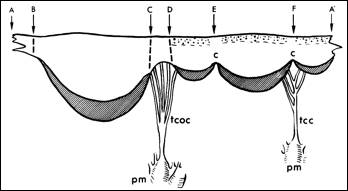
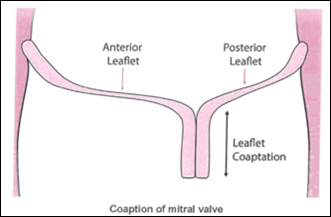
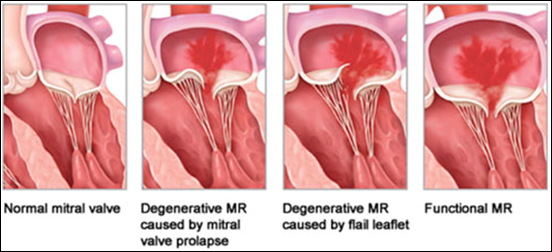
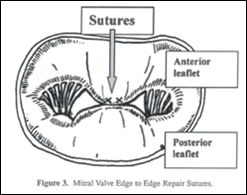
Long felt want, commercial success and statements of case
"I have not taken into account the unpleaded commercial success argument advanced by Olaplex, including the cross- examination materials referring to the Holy Grail and some parts of Mr Christal's testimony. The evidence does suggest that maleic acid or derivatives of it do have some genuine effect to reduce hair damage cause by oxidation, but that just goes to show that the invention works and so there is no insufficiency. Whether it is all worth the social media hype is quite another matter and so too is whether any of that properly establishes a long felt want. This was another transparent attempt to avoid the clear provisions in the rules "
"what is the defect [in the prior art], if there be one, how it was overcome and whether long-felt want is being sought to be established and, if so, how the plaintiffs are going to say they are going to establish it"
The 850 patent
"The most common treatments for mitral valve regurgitation rely on valve replacement or strengthening of the valve annulus by implanting a mechanical support ring or other structure. The latter is generally referred to as valve annuloplasty. A recent technique for mitral valve repair which relies on suturing adjacent segments of the opposed valve leaflets together is referred to as the "bow-tie" or "edge-to-edge" technique. While all these techniques can be very effective, they usually rely on open heart surgery where the patient's chest is opened, typically via a sternotomy, and the patient placed on cardiopulmonary bypass. The need to both open the chest and place the patient on bypass is traumatic and has associated morbidity."
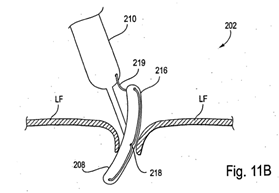
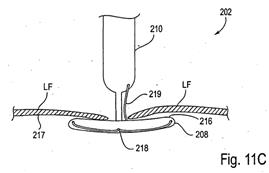
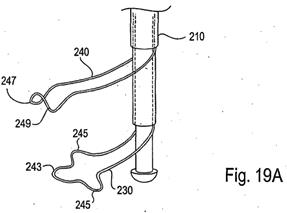
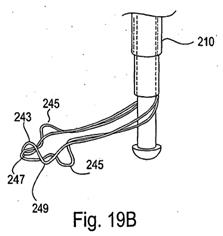
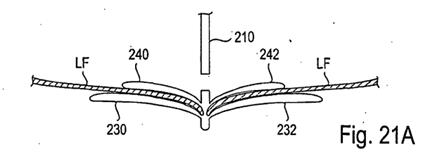
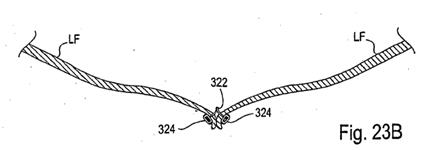
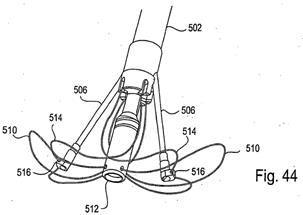
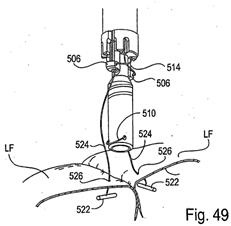
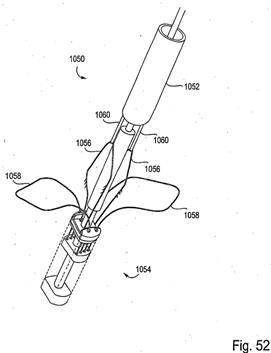
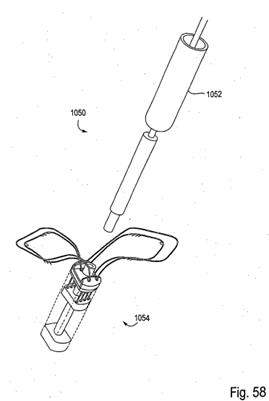
Claim construction the 850 patent
"[0052] In many embodiments, the distal elements are individually extendable, retractable and repositionable. Fig. 13 illustrates the extension of a first element 230 independently of the second element 232. Such elements 230, 232 may be utilized in this arrangement or the second element 232 may be extended at any point during the procedure."
"4. A device according to claim 1, wherein each of the distal elements and each of the proximal elements is independently extendable, retractable and repositionable."
Inventive step over Deem
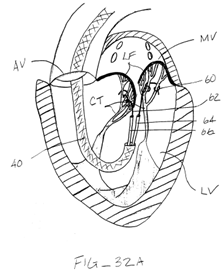
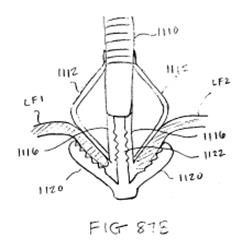
What works and what doesn't
The obviousness case
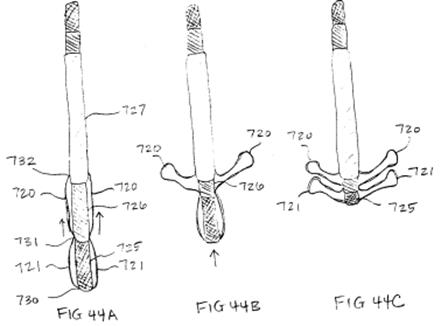
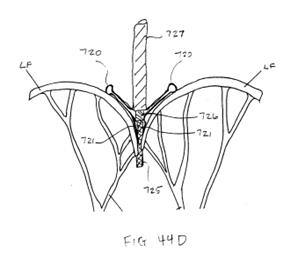
i) The distal end of the ribbon is mounted to the innermost shaft (725) at the end at point 730.
ii) The midpoints of the ribbon on either side are mounted on the end 731 of the central shaft (726).
iii) The proximal ends of the ribbon on either side are attached to end 732 of the outermost shaft (727).
Added matter
i) a capture device detachably connected to an interventional catheter in which both the proximal and distal elements are movable between a retracted position adjacent the shaft of the catheter and an extended position extending away from the said shaft (in effect feature F of claim 1);
ii) a capture device in which the proximal and distal elements are movable between a retracted position adjacent the shaft of the capture device and an extended position extending away from the said shaft (in effect feature F of claim 11);
iii) a capture device comprising a shaft having a proximal end and a distal end with proximal and distal elements disposed near the distal portion of the said shaft (in effect feature E of claim 11).
"In a number of embodiments, an example of which is shown in Figs. 17A-17D, the interventional tool 204 also comprises proximal elements 240, 242 which are capable of protruding radially outward from the shaft at a location which is proximal to the elements 230, 232 previously described. The proximal elements 240, 242 may have any of the forms, shapes, material compositions, features, or capabilities described in relation to the distal elements 230, 232."
Infringement
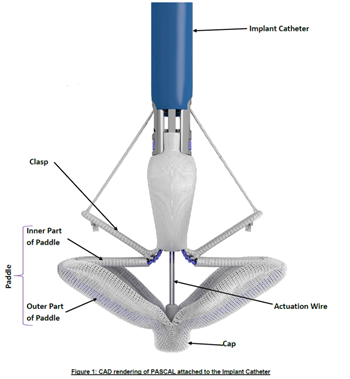
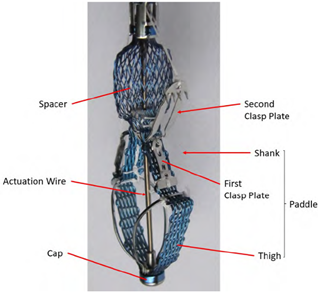
closed elongated
The 810 patent
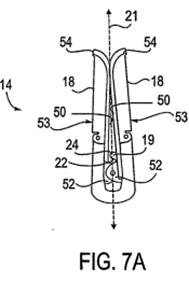
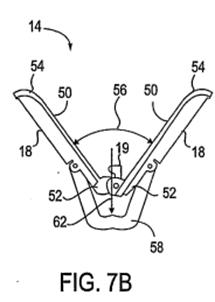
Fig 7A - Closed / Delivery position Fig 7B Open position
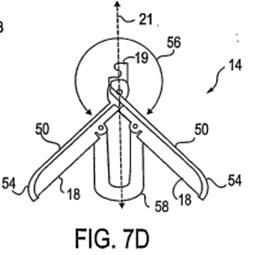
Fig 7D Inverted position
"[0062] Under some circumstances, it may be further desirable to withdraw the fixation device 14 back through the valve or completely from the patient following initial insertion through the valve. Should this be attempted with the clip in the closed or open positions illustrated in Figs. 7A-7C, there may be a risk that arms 53 could interfere or become entangled with the chordae, leaflets or other tissues. To avoid this, the fixation element 14 is preferably adapted for inversion of arms 53 so that free ends 54 point in a second direction, opposite to the first direction in which the free ends 54 pointed in the closed position, each arm 53 forming an obtuse angle relative to axis 21 as illustrated in Fig. 7D. The arms 53 may be rotated so that the engagement surfaces 50 are disposed at a separation angle 56 of up to 360 degrees, and preferably at least up to 270 degrees."

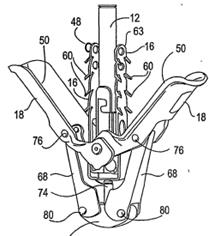
Figure 9 Figure 11B
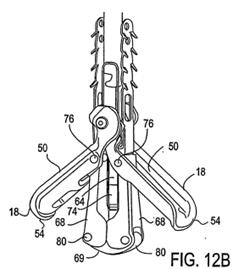
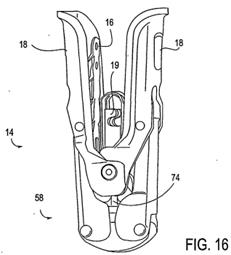
Claim construction the 810 patent
Infringement
The way the PASCAL device works
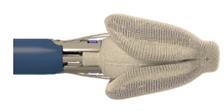
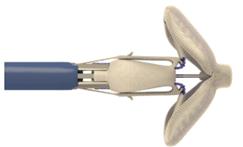
closed position capture ready position
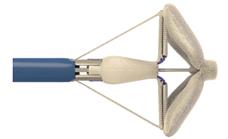

captured position elongated or reposition position
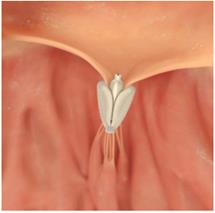
The easy subsidiary claims and Modified Conditional Amendment F
Claim 1 - Abbott's primary case
"The devices [the patent and PASCAL] provide a different solution to the same problem. The fixation elements do not invert around a hinge point at the shaft. They bend in the middle. So rather than invert into a position for withdrawal, they flatten and extend into a position for withdrawal, just as with the Goldfarb Fig 18 embodiment. This is not the invention claimed. It does something different (elongate rather than invert) in a different way (by pulling the two axially fixed ends apart). It is not surprising that it cannot be fitted into the claim. The equivalence case comes down to a general assertion that the device achieves something similar to the 810 Patent in that PASCAL can also be put into a position where it is suitable for removal. That is plainly not good enough."
[closing paragraph 50]
Claim 1 -Abbott's secondary case (and whether it is open)
Claims 18 and 19
Validity
Novelty - Goldfarb
Inventive step
The law embodiments as starting points
"182. The defendants also relied on Brugger v Medicaid for the proposition that "the mere existence of alternatives is not in itself an argument against obviousness". I agree that the mere existence of obvious alternatives is not in itself an argument against obviousness. Before Brugger was decided there was sometimes a tendency to place too much emphasis in argument about alternatives as if they always established inventiveness, on the other hand undue focus on Brugger itself can mislead too, discounting alternatives altogether. The correct proposition about alternatives is the statement of Kitchin J in Lundbeck [2007] RPC 32 approved in Conor [2008] UKHL 49 which I have cited above. It is an important statement because it is a balanced one. "
"The question of obviousness must be considered on the facts of each case. The court must consider the weight to be attached to any particular factor in the light of all the relevant circumstances. These may include such matters as the motive to find a solution to the problem the patent addresses, the number and extent of the possible avenues of research, the effort involved in pursuing them and the expectation of success."
The facts
(1) The implant must be detachable i.e. capable of being detached from its delivery device and left in situ.
(2) The device must be able to capture and hold the valve leaflets securely and permanently without causing significant trauma or damage to the valve leaflets.
(3) The implanted device must not embolize i.e. become detached, causing an arterial blockage.
(4) The device must be redeployable, that is to say the operator must be able to reposition the device so to achieve optimal valvular function before it is finally implanted. In other words a 'one-shot' design would be unsuitable.
(5) Chordal entanglement/entrapment or damage to other tissue or leaflets should be avoided.
(6) The valve leaflets should be held together in a manner that resembles normal coaptation, in other words there should be anatomically accurate repair.
(7) The delivery profile must be sufficiently small to enable the device to pass through the vasculature of the patient and the general rule is 'smaller is better'.
(8) Avoiding interference with the chordae. If implanting via the antegrade approach, it would be desirable to be able to withdraw the device back into the atrium before attempting another leaflet capture in order to avoid interference with the chordae.
(9) Removability. If cardiac function cannot be improved, it would be desirable to have the option of removing the device entirely from the patient without causing significant damage to the heart itself.
(10) It would be highly desirable to cover the device with a material that allows endothelial growth into the fabric, thereby helping to anchor the device in place and reducing thrombogenicity.
What would the skilled team make of Goldfarb
Device geometry
Nitinol issues
Making figure 18 detachable
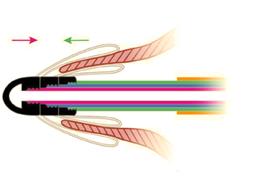

Figure 5 Figure 6
Detachability and enabling disclosure
Other features
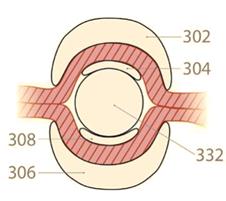
Obviousness conclusions
Claim 1 - equivalents
Question 1: does the variant achieve substantially the same result in substantially the same way as the invention?
Question 2: Would it be obvious to the person skilled in the art, reading the patent at the priority date, but knowing that the variant achieves substantially the same result as the invention, that it does so in substantially the same way as the invention?
Question 3: Would such a reader of the patent have concluded that the patentee nonetheless intended that strict compliance with the literal meaning of the relevant claim(s) of the patent was an essential requirement of the invention?
Actavis question 1
"The first Improver question, whether the variant has a material effect on the way the invention works, was addressed by Lord Neuberger at [60]. He thought this was generally satisfactory but the court must focus on "the problem underlying the invention", "the inventive core", or the "inventive concept". In effect the question is whether the variant achieves the same result in substantially the same way as the invention".
Actavis question 2
Actavis question 3
Equivalents - conclusion
Amendment
Conclusion
Annex 1: The claims of the 850 patent
A A device adapted for repairing a cardiac valve in a patient, the cardiac valve having leaflets,
said device comprising:
B an interventional catheter comprising a shaft having a proximal end, a distal end and a longitudinal axis therebetween, configured to pass to a position within the heart adjacent to the cardiac valve;
and
C a capture device detachably connected to the catheter
comprising
D at least two extendable distal elements and at least two extendable proximal elements,
E each of the proximal and distal elements being disposed near the distal portion of the shaft
and
F being moveable between a retracted position adjacent the shaft and an extended position extending away from the shaft for capturing the valve leaflets;
characterized in that
G the at least two distal elements and the at least two proximal elements are independently extendable, retractable and repositionable
H so that they are adapted to be extended or retracted by various amounts for protrusion of various distances from the shaft.
A device as in claim 1, wherein the at least two proximal elements are interlockable with the at least two distal elements.
A A capture device for repairing a cardiac valve having valve leaflets,
the capture device comprising
B a shaft having a proximal end and a distal end;
C a coupling mechanism disposed near the proximal end of the shaft for coupling with an interventional catheter;
and
D at least two extendable distal elements and at least two extendable proximal elements,
E the proximal and distal elements being disposed near the distal portion of the shaft
F and being moveable between a retracted position adjacent the shaft and an extended position extending away from the shaft for capturing the valve leaflets;
characterized in that
G the at least two distal elements and the at least two proximal elements are independently extendable, retractable and repositionable
H so that they are adapted to be extended or retracted by various amounts for protrusion of various distances from the shaft.
A capture device as in claim 11, wherein the at least two proximal elements are interlockable with the at least two distal elements.
Annex 2: The claims of the 810 patent
A A fixation device for engaging tissue
comprising
B a pair of fixation elements each having a first end, a free end opposite the first end, and an engagement surface therebetween for engaging the tissue,
C the first ends being movably coupled together such that the fixation elements are moveable between 1) a closed position wherein the engagement surfaces face each other, and 2) an inverted position where the engagement surfaces face away from each other;
and
D an actuation mechanism coupled to the fixation elements adapted to move the fixation elements between the closed position and the inverted position,
E further comprising a pair of gripping elements, each gripping element moveable with respect to one of the fixation elements and being disposed in opposition to one of the engagement surfaces so as to capture tissue therebetween,
wherein
F the gripping elements are moveable from an undeployed configuration in which each gripping element is separated from an opposing engagement surface, to a deployed configuration in which the gripping element is adjacent to the opposing engagement surface
and wherein
G each fixation element is at least partially concave and each gripping element is at least partially recessed within the fixation element in the deployed configuration
or wherein
H the gripping elements are approximately parallel to each other in the undeployed configuration.
A fixation device as in claim 1, wherein the fixation elements are further moveable to an open position between the closed position and the inverted position.
A fixation device as in claim 1, wherein the gripping elements have frictional features configured to enhance grip on tissue engaged thereby.
The fixation device of any one of the preceding claims, further comprising a coupling member for detachably coupling the fixation device to a delivery device.
The fixation device of any one of the preceding claims, further comprising a covering on the fixation elements adapted for promoting tissue growth.
A fixation device as in any one of the preceding claims, wherein the fixation elements have longitudinal edges between the first end and the free end, the longitudinal edges being curved about a longitudinal axis away from the engagement surfaces.
A fixation device as in any one of the preceding claims, wherein the free ends of the fixation elements curve away from the engagement surfaces about a transverse axis generally parallel to the engagement surface, wherein the free ends of the fixation elements are curved about a second axis not parallel to the transverse axis.
A A fixation device for engaging heart valve tissue for the repair of a valve of the heart
the fixation device comprising
B a pair of fixation elements each having a first end, a free end opposite the first end, and an engagement surface therebetween for engaging the tissue,
C the first ends being movably coupled together such that the fixation elements are moveable between 1) a closed position wherein the engagement surfaces face each other, and 2) an inverted position where the engagement surfaces face away from each other, wherein in the inverted position the engagement surfaces provide an atraumatic surface to deflect tissue
and
D an actuation mechanism coupled to the fixation elements adapted to move the fixation elements between the closed position and the inverted position,
E further comprising a pair of gripping elements, each gripping element moveable with respect to one of the fixation elements and being disposed in opposition to one of the engagement surfaces so as to capture tissue therebetween,
wherein
F the gripping elements are moveable from an undeployed configuration in which each gripping element is separated from an opposing engagement surface, to a deployed configuration in which the gripping element is adjacent to the opposing engagement surface
and wherein
G each fixation element is at least partially concave and each gripping element is at least partially recessed within the fixation element in the deployed configuration
or wherein
H the gripping elements are approximately parallel to each other in the undeployed configuration.


